#one post had “this is what russian culture looks like”
Text
Looks like it's time to talk about starseeds and the New Age movement again.
Since I'm seeing more starseed content being posted, I'm gonna make another post on why the whole starseed thing and the surrounding New Age belief system are... not good.
So for those who don't know, New Age mythology is essentially a hodgepodge of cherrypicked and distorted myths from various cultures, racist pseudohistory, and far right conspiracy theories. To put it very briefly, starseeds are supposedly here to help Earth resist the reptilians, a race of politics-manipulating, war-starting, media-controlling blood-drinking aliens. For those who don't recognize the tropes here, these are basically all antisemitic canards. The reptilian alien myth as most know it today comes from David Icke, who ultimately cribbed a bunch of his material from The Protocols of the Learned Elders of Zion, a Russian hoax created to justify violence against Jews. He was also influenced by the work of people like Fritz Springmeier, a hateful crank who based much of his work on other hateful cranks.
(David Icke, by the way, also claims that transgender is an evil reptilian conspiracy. You'll never find just one form of bigotry with these people.)
There are supposedly numerous alien races out there, and one of the most prominent among them are the Pleiadians, AKA Nordics. While modern depictions of the Pleiadians give them more variety in skintone, there's no denying that older Pleiadian mythology basically pictured them as Aryans In Space, even associating them with the swastika.
You see what's going on here? "Good" swastika-loving Aryan aliens versus "evil" Jewish aliens? Sound familiar?
Racism isn't just a tangential part of the starseed myth, either. It lies at its very core. It's inextricably tied in with the ancient astronaut hypothesis, which has a history of racist motivation behind it. The TL;DR is that a bunch of white people couldn't believe that non-white people had built a bunch of things they couldn't figure out how to build themselves (EG, the Great Pyramids), so they proposed that the real builders were anyone from Atlanteans to aliens. (Atlantis, by the way, never existed; it was a literary device created by Plato.)
One supposed purpose of starseeds is to help the world "wake up to the truth," which basically just means "convert people to New Age spirituality." New Age believes that world peace is contingent on a majority of the world being converted to New Age belief, and that resistance against their belief system is ultimately the work of the aforementioned reptilian aliens.
To put it another way, New Agers think they understand other cultures' spiritual traditions better than the actual members of said cultures, and think that anyone who disagrees with them is being manipulated by the conspiracy, or is an agent of the conspiracy. This includes Indigenous cultures which are already endangered from white Christian colonialism.
Essentially, endangered cultures cannot speak up for themselves and resist New Agers' efforts at cultural assimilation without being labeled a problem and an enemy. It's basically white Christian colonialism repackaged as "spiritual, not religious."
Again - if you heard from these people that some ancient text or myth describes extraterrestrial beings visiting our planet for one reason or another, you heard misinformation. They twist and misrepresent literally every myth and text they get their hands on. For example, you may have heard that the vimanas from Hindu traditions were actually alien spacecraft. They were no such thing. Or maybe you heard that the Book of Enoch describes aliens performing genetic experimentation on humans. It literally does not. At best, all of the stories they cite just kind of sound like aliens if you ignore most of their content and pay no attention to their cultural contexts.
The starseed movement preys on alienated people, especially autistic people and people with ADHD. You can look up nearly any list of signs that you're supposedly a starseed, and many of them will align perfectly with characteristics associated with autism and/or ADHD, or that people with these conditions commonly report. Some people within the movement even go so far as to claim that ADHD and autism don't even exist, but were actually made up by the conspiracy as a cover to suppress and control starseeds, which is some yikes-as-hell ableism.
So basically, people are being told that if they have these certain characteristics or symptoms, that means it's their job to spread New Age spirituality to defeat the conspiracy and help others ascend to the fifth density.
And what's the fifth density, you might ask? It's supposedly humanity's next evolutionary level, because New Age is also based on biological misconceptions. Supposedly once everyone's DNA "upgrades," they'll essentially morph into an aetheric form. Supposedly, this is preceded by a number of "ascension symptoms," including depression, headache, gastrointestinal issues, and any number of other symptoms that could indicate almost anything, including stress.
What many of these people don't realize is, this prediction has already failed. Back in the 2000s and 2010s, experiencing "ascension symptoms" was supposed to precede ascension to 5D beginning December 21, 2012. One lady, Denise Le Fay, was convinced that the hair loss she was experiencing in 2008 was an ascension symptom. As we can see by looking her up, she's very much still with us on the 3D plane these days, repeating the same tired old scripts New Agers recycle endlessly.
By the way, everything you near New Agers saying today about old systems being dismantled, dark forces being arrested or kicked off the planet, and new economic systems on the horizon? They've been recycling these scripts for years now. Take a look at this page written back in 2012. You got stuff about the complete dismantling of an enormous network of sinister forces," "the arrest and removal of a world-wide cabal," and a "new economic system."
("Cabal," by the way, is a dogwhistle term for "Jews.")
Furthermore, people in this movement are often encouraged to try and access past life memories through dreams or hypnosis, which makes the whole thing feel even more real to them. But the thing is, you can have incredibly vivid experiences about literally anything you put your mind to - the people in the reality shifting having vivid experiences of living another life in the Harry Potter universe are a great example of this. Just because you have vivid experiences, doesn't mean they have any bearing on anything happening in this reality.
So yeah, the starseed movement and the larger New Age movement are both extremely harmful. They promote racist pseudohistory, medically-irresponsible pseudoscience, conspiracy theories that target numerous marginalized groups, and functionally target aliened people with ADHD and autism to convince them that spreading its beliefs is their job.
#starseed#starseeds#new age#new age beliefs#ascension#5d#fifth density#spirituality#racism#antisemitism#ableism#transphobia#ascension symptoms#conspirituality#conspiracy theories#conspiracism#ancient aliens#ancient astronauts#ancient astronaut hypothesis#aliens#extraterrestrials#pseudoarchaeology#archaeology#pleiadians#pleiadian#dna upgrade#autism#adhd#colonialism
1K notes
·
View notes
Note
Hey, I noticed that in one of your posts you showed an Iron Age Finnish woman's dress. Would you happen to have a good idea of what Finnish men were wearing in that era? The information on it seems sparse. I do have a relevant book that I'm about to look through, but I'd like to hear your insight too!
Hi! Thanks for the question (and sorry for the slow answer), I do love Finnish Iron Age clothing so it's always my pleasure to write about it. I've been wanting to do a deep dive into this for a long while, so maybe I'll do at some point a post about women's dress too.
Unfortunately no one has good idea of the Finnish Iron Age men's dress (and if you find any book or other source that claims otherwise, do not trust it), since there's much fewer archaeological finds of men's dress than women's dress. The most accepted theory on why the textiles of women's dress survived surprisingly well is because of the bronze ornamentation commonly sewn into especially the fine women's dresses of the era. The bronze protected them from decomposing fully. Presumably men's dresses were not decorated similarly then. There are some finds though and we can piece together at least some kind of vague picture.
I will be discussing the period from Viking Age to Crusade Age in Finland. Viking Age is often defined to cover 800s to mid-1000s and the Finnish Crusade Age started right after the Viking Age and ended in the end of 1200s, where the Finnish Medieval era begins. Crusade Age refers to the period where mostly Swedish (also German) crusaders in the span of couple of centuries conquered lands of the Baltic-Finnic pagans. The crusades of this period targeted pagans all over eastern Baltic Sea, including Baltic-Finnic Karelians, Livonians and Estonians, and Baltic peoples, and the Scandinavia too, where Sámi people were targeted. After that the Finland and Sápmi were colonized by Norse people and stayed that way untill Finland was transferred under Russian rule, but to this day Sápmi still stays under colonial rule, including Finnish colonial rule. The current Finland was very multicultural area, mostly populated by Finno-Ugric peoples, including Sámi people, Karelians and various Finnish peoples.
It's important to understand that even just Finnish peoples where not homogeneous, but had distinct, yet of course strongly related cultures. These were Finns (suomalaiset) (yes most people we now call Finns were not in fact called that) in the coast of southwestern and western Finland, Tavastians (hämäläiset) in central-western lake-Finland and Savonians (savolaiset) in central-eastern lake-Finland. This means we can't mix findings from all over Finland to reconstruct a dress without evidencing that all the elements were actually used in one place. These three tribes had broadly similar base for their clothes, but distinctive jewelry and detailing. The big divide was and has always been between eastern and western Finnish peoples. This is because western Finnish people were in close contact through the sea with Norse people and southern Baltic-Finnic peoples, while eastern Finnish people, Savonians mostly, were influenced a lot by their proximity with Karelians. Another dividing factor was the very different environmental conditions between western and eastern Finland. The Finnish coast especially in west is very flat and fertile land, while the lake area, especially in eastern Finland is very rocky, hilly and quite infertile. The main way it effected clothing differences was that western Finland being more wealthy had more elaborate clothing. Tavastians in both occasions fall quite in between, but they tended to be more in the western cultural camp.
My most important sources are a study by a doctor of cultural anthropology, Jenny Kangasvuo, Savon historia I (Savonian history) digitized and open sourced here and the digitized archeological collection of Finnish Heratage Agency. They are all in Finnish so not very useful for most people unfortunately.
Finnish Men's Dress in Viking and Crusader Ages
The basic garments men wore were broadly similar as women. They wore a shift/shirt, knee or above-knee length dress, cloak, belt, shoes and some kind of headwear. Wool was used most commonly, though the shirt would sometimes be linen too. Even evidence of silk has been found in some western Finland graves. I would assume that would be from a dress of some great man, who traveled to gain riches, possibly with vikings. Embroidery and decoration with metals was a typical feature of the whole Eastern Baltic Sea area. In Finland during this period bronze was the most common decorative metal, but silver was used too. Decorative elements were usually woven with small bronze spirals into all kinds of patterns. Here's examples from the reconstructed Ravattula's dress (Finns) used by women.
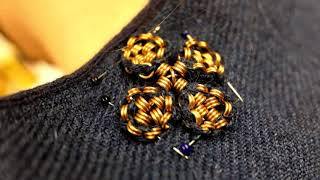

Shirt
The shirt (in Finnish shift of both women and men was called shirt) was basically a long shirt or under dress. We can assume it was similar to those of women's except shorter since the dress men wore was shorter too. They were made from wool or linen, I would assume wool was used in winter and linen in summer, when linen was even available. The neckline had a cut and closed with a bronze brooch. Horseshoe brooch was common. The first one is a quite typical bronze horseshoe brooch with a bit of ornamentation from Salo (Finns). The second one is from Tuukkala, (Savonians), it has exceptional ornate detailing and is uncommonly silver, not bronze. The third picture has two quite uniquely ornamented horseshoe brooches, first from Köyliö (Finns), second from Kurikka (Finns).
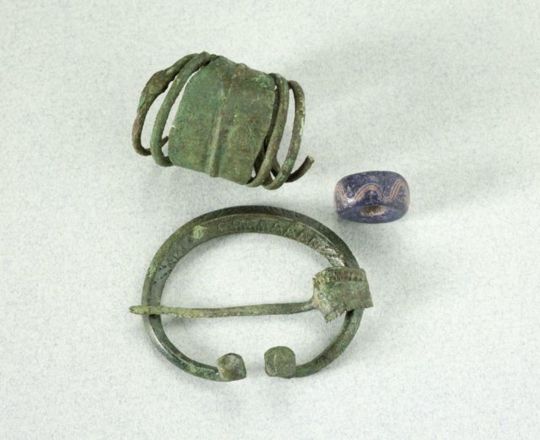
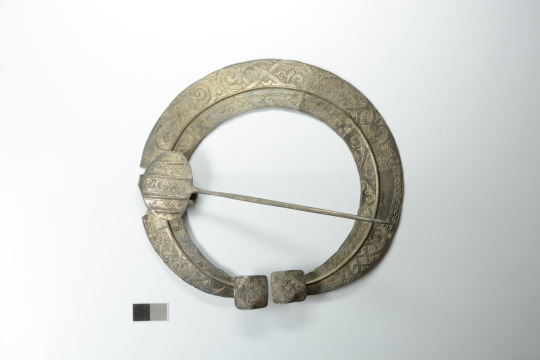
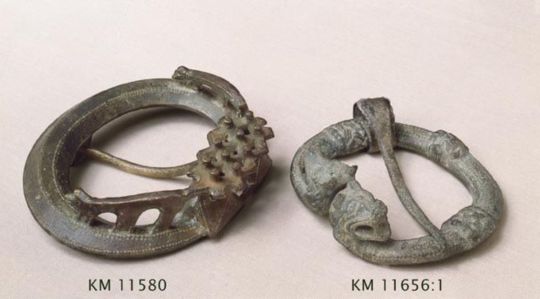
Legwear and footwear
Very little of men's legwear has survived and it's unclear weather men wore pants or separate pant legs, leg wraps or perhaps long socks. Evidence of strings decorated with bronze spirals and tablet woven band has been found in leg area of men's graves. This could mean that they wore either leg wraps, long sock or some sort of pant legs that needed to be secured with string or band under knee. Women used strings and tablet woven tape to secure leg wraps and socks, which I think supports that theory. Sometimes both bronze decorated string and tablet woven band was found in the leg area, which would still be explained by this theory, since it was common to decorate the ends of the bands with bronze decorated strings. Here's an example of sock bands just like that from the earlier mentioned reconstruction of the Ravattula's women's dress. Since men's dress was shorter, I think it would make sense if they still wore some kind of pants or separate pant legs with socks or leg wraps like that.
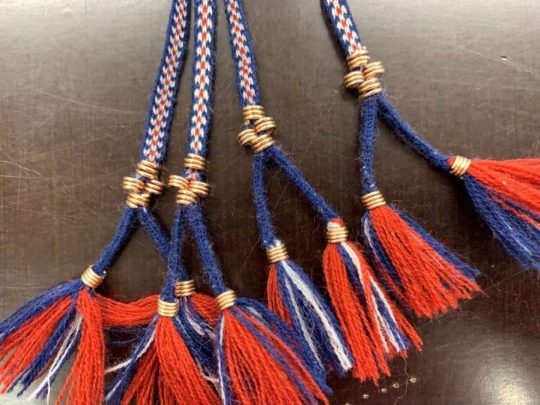
However, the strings and bands could have also been part of the shoes. Everyone probably wore similar shoes - laced leather shoes with a bit of pointed end. They might have been short or ankle length and the lacing was done with either leather cord or tablet woven band, which would also explain the findings. Socks or feet wraps would have been used in them, and straw or wool could be added as filling for warmth. Here's a pair of traditional Izhorian shoes from Estonia from early 1900s, and a pair of traditional Sámi shoes. The designs were likely roughly similar in Viking and Crusader Ages, though obviously more simple, and it's probable that Finnish shoes very something like that too. Here's a 1893 drawing of what findings of shoe material from Korpiselkä (Savonian or Karelian) might have looked like. Considering the quality of archaeology of that time, copious amounts of salt should be applied. And finally as a fourth picture there's reconstruction shoes from Ravattula's dress.


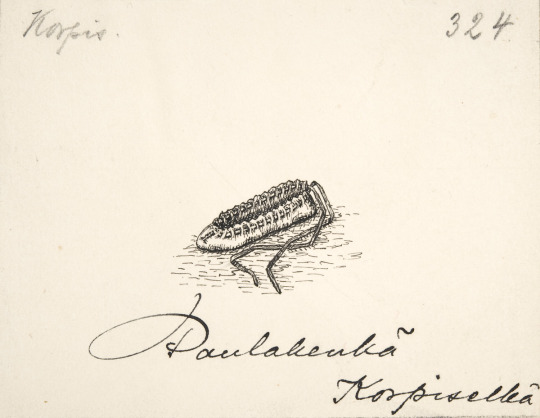
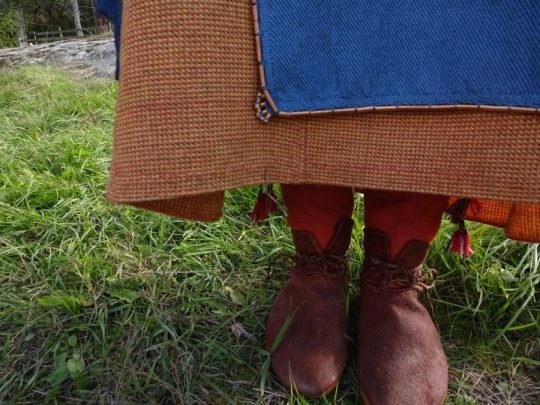
These are not necessarily mutually exclusive theories. The lacing of the shoe could have been laced up the leg and used also to secure either sock or leg wrapping, or they could have been separately secured in ankle and knee respectively.
In some graves twill fabric has been found in the leg area. It could be part of pants or for example leg wrapping, which was often made of twill. One theory about pants is that they were similar as some findings in Sweden, where fairly tight pants made of twill were secured at the hem with buttons similar to cuff studs. These kinds of cuff stud buttons are quite a common find in Finland and some have been found in men's graves close to legs.
Dress
Again there's not much findings of dresses, but a little more perhaps. It was usually from wool. The shape was either a tunic or an open coat. In Karelia there's findings of men's dress suggesting tunics thicker than women's dresses and made from sarka, a type of broadcloth. On the other hand, in Masku (Finns) they found buttons in a row on top of the torso, which suggest a coat closed with buttons. The first picture is a drawing of the grave find. Similary coak closing amounts of buttons have also been found in other places in western Finland. This suggests that Finns and probably Tavastians too wore long coats buttoned to the waist and Savonians wore tunic of Karelian influence. Below there's couple of version of what might this western Finnish men's coat dress could've looked like. The first is an imagined version of the coat based on the Masku grave finds, second is just as imagined version based on Eura (also Finns) grave finds.
Take these "reconstructions" with a strong dose of salt. These are more artistic reconstructions than scientific, since there's not enough material and too much guesswork needs to be done. And because we can see in the Masku grave drawing right here that the other deceased has a large buckle to (probably) close the shirt (to be fair, it could for a cloak too), like was typical, I find it implausible that the coat neckline would be small and round covering the buckle. If you make a decorated big buckle, I assume you want to show it. I would find a v-neckline more probable. It's also easier to make without wasting expensive fabric.

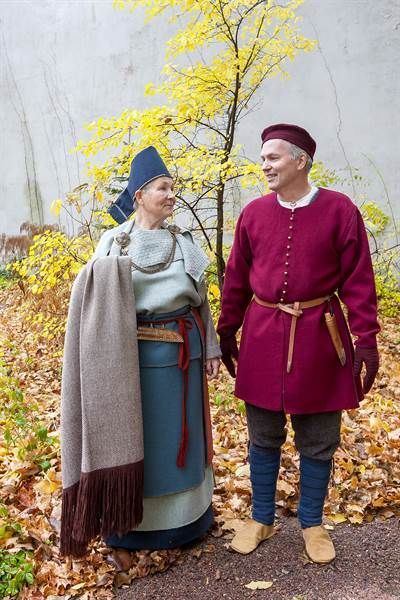

The buttons are interesting. There were what you would imagine - your typical buttons made of bronze like seen in the first artifact from Hattula (Tavastians). But then there was silver jingle bells used as buttons, found for example in both Masku and Eura graves, Eura findings pictured below.


It's possible, even probable I'd say, that the hemlines of men's dresses were finished with tablet weaving patterns, like women's dresses. Also I would assume the pattern of the men's dress (and shirt) was mostly similar to the women's underdress/shirt patterns. So here's couple of different reconstruction patterns for women's dress. Different historians have made different interpretations of the patterns, so it's very much undecided what it really was like.
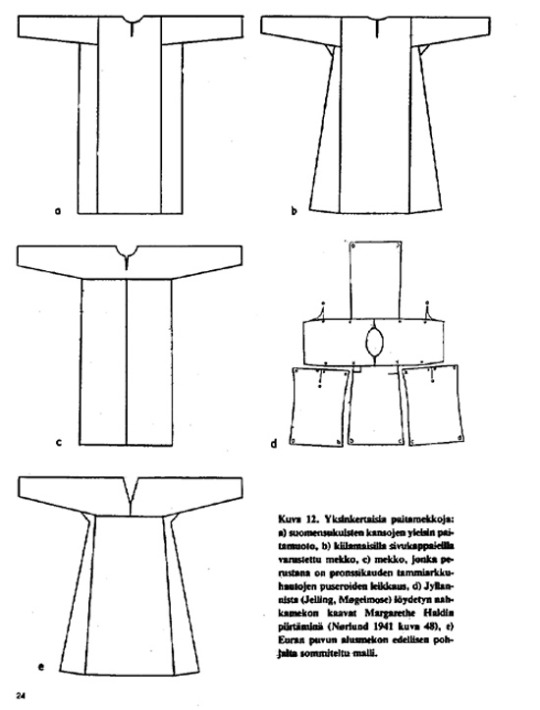

Belt
This is likely the most ornamental part of men's dress. They could be made out of leather or tablet woven band. And there's another east-west cultural divide here. Karelian belts were made out of leather, were usually 1,5-2,5 cm wide, decorated with iron or bronze studs and had a buckle made out of iron or bronze. These types of belts have been found in Savonia too, for example in Tuukkala grave find, which you can find very cool pictures of in this photo documentation of the dig in pages 173-175. In western Finland a "hela" belt was the common style. I don't think there's a world for hela in English. It's a sort of decorative lamella, small metallic plate (not necessarily square but often so) attached to fabric or leather with studs or sewing. Hela belt came from the Permians of Kama river, who were one of the many Finno-Ugric peoples who used to populate much of European side of Russia. Karelians lived closer to Permians, so you might think Permians would influence eastern Finland more, but my theory is that the costal Finns, who frequently joined viking crews and at least were in close contact with merchants including vikings, who would travel along the eastern route through the eastern European rivers, where they could go all the way to Kama river or at least meet traveling Permians. Here's yet another Finnish source more on the Finno-Ugric people around Kama river.
Anyway, hela belt was made of leather and filled with small decorated lamellas, often in square shape, but various other shapes too, like animal ornamentation. In this period hela belt helas were bronze. First image is a nice full set of hela belt metal pieces found in Pirkanmaa (Finns). Second is an older example, right before Viking Era, from Vaasa, costal settlement, (Finns), depicting a very Permian style. The third one is a lion hela found separately in Pälkäne (Tavastians). They are also found in Tuukkala, showing that both eastern and western cultural influences were present there at the same time.

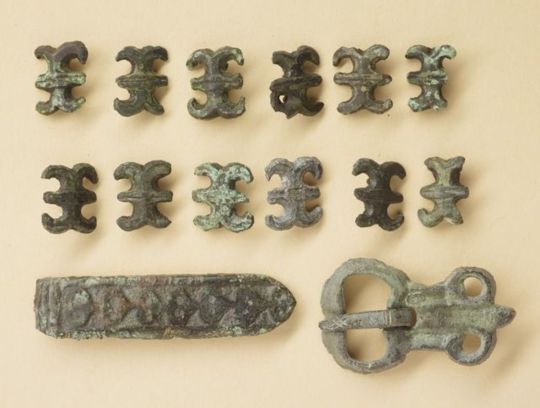
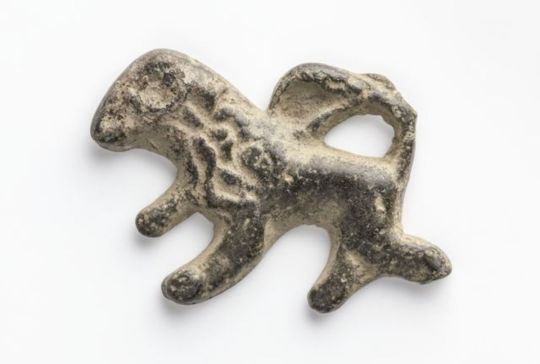
Another western Finnish belt type for men had intricate tassels decorated with bronze spirals hanging on the waist at the end of the belt. They could be made out of leather or tablet woven band. First image depicts a reconstruction of such tassel. Belts in east and west would have strap dividers to hang straps for things like purse, knife and sword. The first picture above has couple of those, but the second picture below has two more of them in more detail in the middle of the picture. These finds are from Lieto (Finns).


Cloak
Like women's cloak, men's cloak was woolen and either a square or trapezoid. Cloak is yet another east-west divide. In western Finland men's cloaks have embroidery with bronze spirals. They in fact appeared earlier in men's cloaks (in 900s) than in women's cloaks (1100s). They were also a little different in men's cloaks. The spirals and the patterns themselves were bigger and the fastening thread itself was also used for the pattern creation, unlike in women's dresses, where the thread was mostly covered. In eastern Finland there has been no finds of bronze decorations in men's cloaks, mostly only cloak brooches have been left of them. Unsurprisinly same applies to Karelia. This also means there's very little fabric left too. There's one exception. In Tuukkala (Savonians) they found a piece of fabric probably from men's cloak, though it could be from a men's dress too. It was striped, with possibly white or brown base and wide stripes of red, blue and yellow. So perhaps eastern Finnish cloak was not non-decorated, but the decoration was in the fabric pattern. Unfortunately it's hard to know how common fabric like that was, when so little of it is left.
Accessories
It's safe to assume men too wore some type of headwear, but none of those has survived. It probably means it was entirely made out of fabric whatever it was. Some type of hat or cap was certainly used in cold weather at the very least. Tablet woven headband was also possible option for not too cold weather.
In Tuukkala there was couple of interesting jewelry finds too. Two graves had a necklace type mostly found in Karelia. It was birchbark tape covered with nettle fabric and had square helas sewn into it. There were also more typical Finnish necklaces made of beads and bronze spirals.
Razors have also been found with men in their burials, so we can assume shaven faces or at least trimmed beards and moustaces were fashionable.
#dress history#historical fashion#historical clothing#fashion history#history#iron age dress#finnish iron age dress#finnish history#archaeology#answers#anon
224 notes
·
View notes
Text
So, um... Originally, I was just planning on doing a little fanart for the cool queen Dream design by @signanothername (and the wonderful @undertale-person, let's not forget), in this post but...
I got carried away. A lot.
Now. This is actually a very long post in which I talk a lot about the culture of my country. If you are interested and want to read this type of post, then go ahead. If not, I just have to warn you that this is 1% undertale au pictures, 9% of pictures related to the russian culture and 90% text.
So if you are ready go ahead:
Everything started with me thinking that it would be cool to add some kind of interesting pattern to her (queen Dream) clothing? But I wanted it to have some meaning. And since the original design was already related to the sun theme, I wanted to have something sun-related too.
And then I for some reason remembered my school's art classes. I was in the 4th grade or something and we studied traditional russian patterns and ornaments. (And for anyone wondering yes I am russian) And on one of the lessons we learned that ancient russian people had different ornaments and symbols on their closing signifying different things, and I remembered that there was a symbol that had the meaning of sun!
I browsed the Internet a bit and found some different variations of that symbol, so I chose the one I liked the most and added it.

(I chose the one on the right)
But the problem is, I got inspired. Too inspired. I liked the new look a lot, and then I had an idea, that maybe it would be cool to add more russian culture related elements, since I haven't seen many examples of russian culture represented in the undertale au fandom (I mean I've seen a lot of russian content for the fandom but it was mostly done by the russian community and for the russian community and therefore mostly received and recognised by russian people), especially on the more western side (I don't know if I phrased it correctly but I hope you get what I mean).
I also associate Dream with the theme of nature, and I knew that the theme of nature played a huge role in the life and culture of the ancient Russian people. So I thought that russian culture would be fitting for Dream (at least in my head it fits).
So yeah. I got carried away, and I made a completely different design.


The important thing I want to point out here is that this design is in no way 100% correct representation of russian culture, I was just inspired by different elements of russian culture and included them in my painting while trying to keep some of the original Dream characteristics and colours. I stylised some of the elements, mixed some of them which you normally wouldn't see together if it was completely accurate. I also didn't do too much research and kind of worked on the design on the spot while I had the inspiration.
Even though I'm russian there's no way I'm a russian culture or history expert, I only made it because I thought it would be nice to do so and maybe it would inspire some of you to learn more about russian culture!
So with that said I'll now explain some of the design elements more!
We already talked a bit about the pattern on the sleeves, the one that means sun. It's called Colovat (Коловат in russian). It can actually also mean happiness and kindness so that's also why I chose it for Dream. People used to put such pattern on their clothes in hopes it brought them and their families luck, happiness, calm and tranquility.
The interesting part is that I've found some other symbols and patterns that ancient russians included in their clothing which can suit Dream. For example, there's this symbol:

It's called Arepei (Арепей or Орепей in russian), and its meaning can differentiate depending on where it is located on the person's clothes, but overall it means happiness, wealth and self-confidence. You can actually see a little bit of this pattern on my drawing if you look closely at the bottom of Dream's dress.
We also have the symbol called The World Tree of Life or The Tree of Kingship. People believed that the gods liked to rest under it's crown, and they put this symbol on their closing believing that the Tree's crown will protect them from bad luck and the evil spirits. Originally I wanted to include this pattern in my art too but I just couldn't find a good place for it so here's one of the examples of what it can look like:

So, the other major part of russian culture that I've included is called Khokhloma (Хохлома in russian).
It's an ancient art that originated from the Nizhny Novgorod region (Нижегородская область in russian). It is a form of wood painting and it most often depicts various plants and animals. It mainly uses colours like black, yellow, red and green. Most often, different kinds of wooden dishes were painted this way. (Which is why my design is not an entirely correct representation since I painted some of the Khokhloma traditional elements on Dreams clothes).
Here are some examples of this beautiful art:



There's is also one interesting fact about the last picture. On this picture you can see some wooden spoons. Such spoons were actually used as a musical instrument by russian people because of the unique sounds the made when you knocked them together, and the art of playing such spoons is still preserved in Russia!
In my painting you can see this art both on clothes and the sun behind Dream's head. The reason the sun is the black/greish colour is that all the pieces painted in the style of Khokhloma had to be painted black first since the background for the colourful elements was always black.
So. That's all I've wanted to say about my Dream design. It was supposed to be a queen Dream design, but the Dream design I created actually reminds me of some of the characters and mystical warriors from russian fairytales. So I guess I made a mystical russian warrior Dream design? I dunno. Anyway, if you got inspired by this post and found the russian culture that I've showcased here beautiful and interesting, please take some time to learn more about it. There's actually so much to it: chastushkies (частушки), epics(былины), tales, fairy tales, chronicles... It's actually very different and diverse!
I would also recommend playing (or at least watching a playthrough) of the game called Black Book (which is available on steam and it's doesn't cost much as far as I'm concerned). It's a game which lore and plot concentrates around the culture of one of the regions of Russia - the Perm region. It may not have the best graphics but it has a professional English translation and even an English dub! It's a rougelike card game but it has an immersive story and the overall atmosphere is amazing! It's the best way in my opinion to learn more about the russian culture and myths if you don't want to just read articles and watch videos.
The last thing I wanna mention is actually a question. Do you want me to make a similar Nightmare design with russian culture elements? Because I already have some ideas for it, and I actually want to tell you more about another type of russian art called Gzhell which elements I want to include in the design, so let me know your opinion.
So yeah, that's all for now, hope this was actually interesting, if I got to inspire even a small number of people I would be super happy!
#digital art#digital artist#undertale#sans au#utmv#dreamtale#dream sans#culture#russia#russian culture#mei art
67 notes
·
View notes
Note
Ronance headcanons?
Ronance Headcanons
I have had the BIGGEST brain rot about these two, you guys don't even know, so please excuse my rambling session in this post. As always- feel free to share your headcanons, opinions, thoughts ideas, just be kind <3
-Robin is the biggest simp to ever exist. Nancy mentions liking a color? Guess who's suddenly adding it all over their wardrobe! A favourite food? She's already learned how to cook it. Allergic to something? Robin will destroy it with her bare hands and make it go extinct to protect her girl.
-Likewise, Nancy would and will kill for Robin (come on Robin tell her to kill for you she wants to)
-Their favourite dates include them sitting in one of their rooms, a movie or music playing as they discuss conspiracy theories or whatever story Nancy is working on
"There's been a ton of missing items from farms in the areas. Animals, tools, bales of hay-"
"could it be aliens?"
"Alie- Robin it's not aliens!"
"What? Interdimensional monsters are real but aliens aren't?"
-Many people assume Nancy would get annoyed by Robins carefree joke centered attitude but actually she calms down whenever Robin tries making jokes.
-She doesn't like when people don't take things seriously, but she knows Robin is taking it serious, but using humour to make sure they don't spiral with the problem
-their relationship definitely started off rocky but with some time, understanding and surprisingly really deep conversations they learn to appreciate the little things about one another.
-Robin loves Nancy's drive and her leadership skills. She makes sure that everyone takes her seriously and if the kids complain about Nancy being a hard ass she brings them back to listen.
"Nancy's not our boss!"
"No, but she's the one keeping you dipshits safe- she knows what she's doing so listen up and quit complaining"
-They kids listen to Robin more and so when she follows Nancy with no complaints, the kids unconsciously follow suit.
-When Nancy gets stressed/aggravated Robin will be there to lend her a shoulder. They're very much leader/Right Hand man coded to me.
-Nancy doesn't know much about queer culture so when she does eventually come out Robin is happy to talk to her about it and share what she knows.
"So we use Blue violets because Sappho used to describe women wearing garlands of them,"
"Sappho?"
"... Do you have a spar 3 hours so I can explain Sappho and Greek poetry to you?"
-They take all kinds of cute little Polaroids that they keep at Robins place


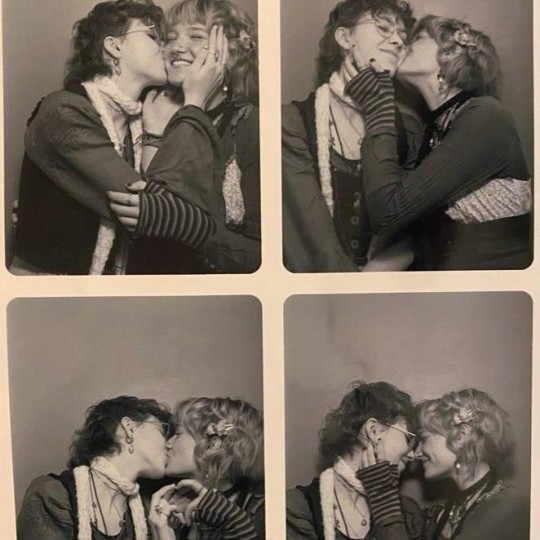

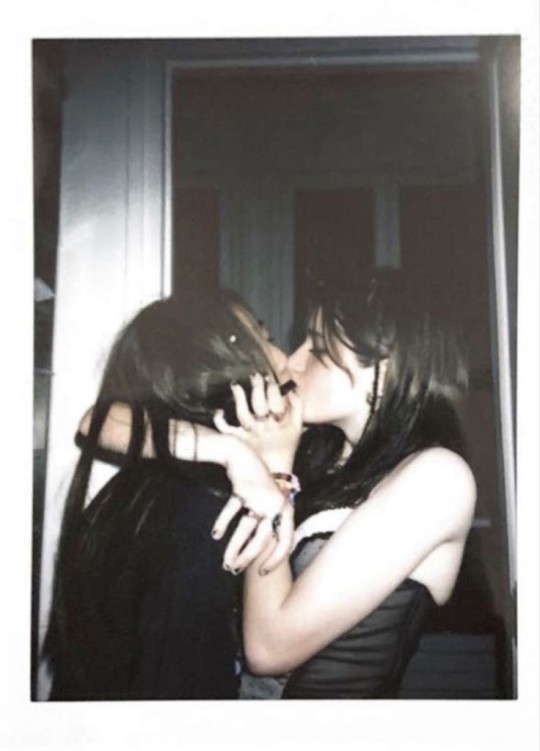
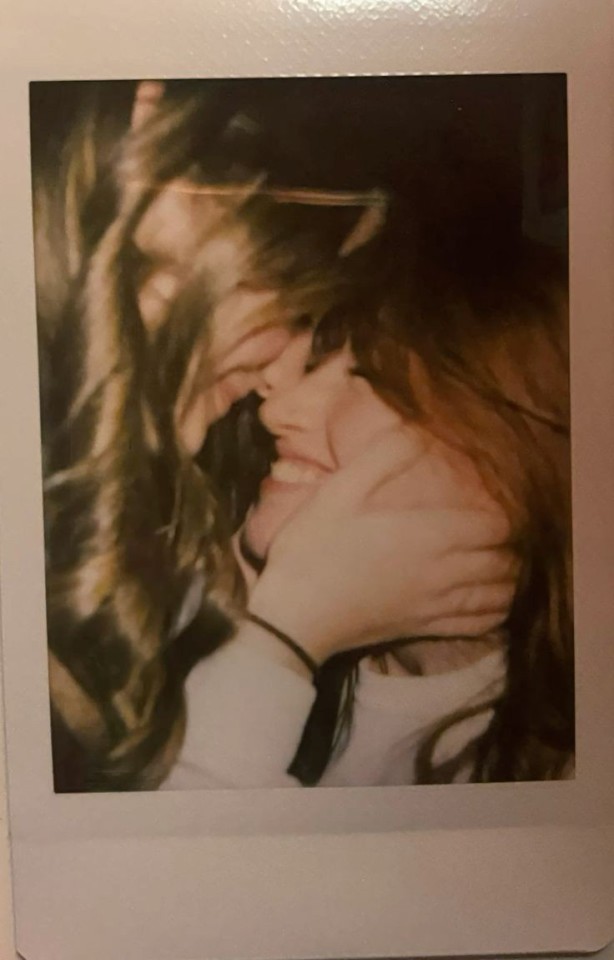
(examples of said Polaroids)
-Robins family is more supportive so often Nancy goes over there to spend the night
-when college comes up in discussions Robin mentions that she enjoyed investigating with Nancy, the research was fun when they didn't have death looming over them.
"Yeah, learning Russian to break the code was awesome- the torture kind of ruined it though-"
"The WHAT?"
-Nancy asks Robin 1000X if Robin is sure she wants to go to the same college/same field and Robin promises her that she isn't only going because of her.
"I'd follow you anywhere, but this is also for me- if I have to do one more customer service job I might kill someone."
-They love movie nights, curled up under a blanket watching whatever film they can find. Robin always finds the oddest ones and sometimes some really deep indie films. Nancy also enjoys the foreign films she can find and let's her choose.
-on nights Nancy chooses- she likes care free fun films. Nothing too heavy because she likes the simplicity
-Theyre a gross matching couple- but in a new fun way.
-Mat hing colors in their respective styles, using each other's clothes and making it go with their personal choices, matching patterns/designs.
-They also shared shoes sometimes
-On the 90s Nancy gets a more "Rachel from friends" style like this

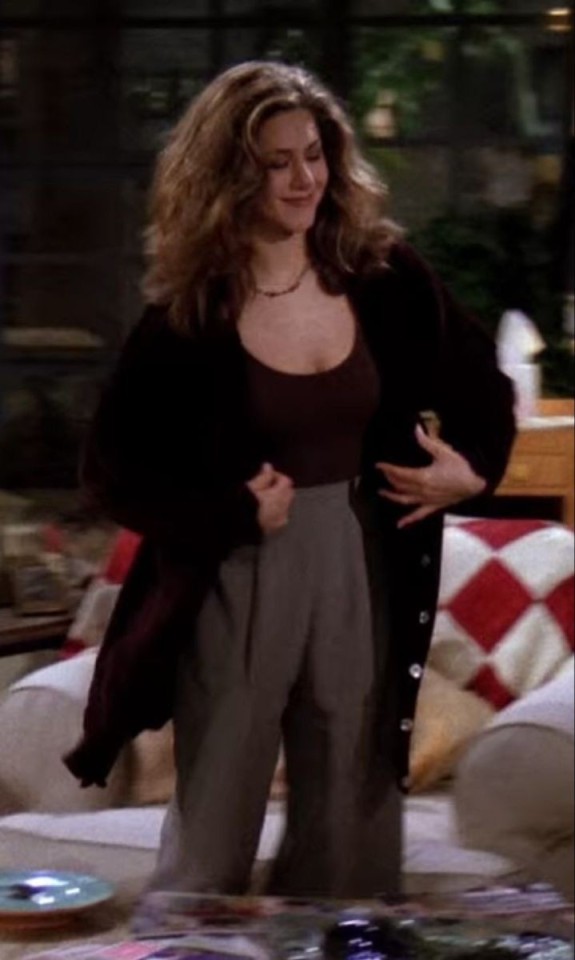


-Robin eats it up like no one is watching and often has to hold back from just kissing her 24/7
(also I badly wanna do a look book of the characters so Please someone ask for that because I love fashion)
I definitely probably have more but here you are!!
#proship#antis dni#proship community#proship please interact#stranger things#ronance#ronance headcanons#robin buckley#nancy wheeler
52 notes
·
View notes
Note
staring so kindly at your sluglang post,, as someone working on a language as well this looks fantastic (and is also. super organized compared to mine BHAHAH)
Any tips for putting together a language? Like resources on how to go about it, or notes? /genq
You are staring kindly... (thank you)
As for tips... Wikipedia is actually one of my biggest, most useful tools, because I love to read articles about grammatical concepts, and they will usually have a varaiety of examples of use if you can figure out how to parse the academic language. There are some core ideas that pop up all over the place crosslinguistically, like case marking or converbs, and you can get a lot from learning how other languages might parse the same idea, both how they handle the idea grammatically and what kind of metaphorical language might be involved; like how in Scottish Gaelic, to say you have something, you say it's 'at' you, or how it doesn't have an exact equivalent of English's infinitive, or how Mongolian has so many word endings that convey meaning, and a bunch of them are literally endings stacked on top of other endings.
There's also really good conlang youtubers, like David Peterson, the one who made Dothraki and other pop media conlangs, Artifexian, Biblaridion. They have videos on both interesting grammatical concepts that don't exist in english AND how to integrate them into conlangs. Davide Peterson especially has interesting videos on things like sound changes, vowel harmony, phonological concepts that can really help shape your language and bring a degree of naturalism if that's what you're looking for.
Etymology can be extremely informative though, and really help you to understand exactly how creative people have gotten with language over the past thousands of years. Etymonline is a great website for that. Did you know that the word "next" was originally literally "nearest"? Or that that the suffix "be-" was originally "by", so words like "before" actually meant "by the fore", and very often these meanings are metaphorically extended to the way we use them today. It's great for helping to develop very important words that can be structural to your language, so that you're not just trying to raw make up a new word with no basis every time.
Aside from that, there's no single source I go to for making conlangs. Everything is on a case by case basis. Something that has been really helpful for me is constantly writing example sentences and finding things to write about, because similar to translating existing texts, it forces me to reckon with the way my conlang works, figure out how to convey certain ideas (or whether or not the language can convey the idea at all).
Usually I'll have a few languages that I keep in mind for inspiration for any given project and if I'm stumped or need an idea, I'll actually look up learning resources for those languages. My slugcat language has had me looking up a lot of "How to say..." in Korean, Arabic, Japanese Filipino, a little bit of Indonesian? Some Russian for verb stuff. Once I find resources, I spend a bit of time dissecting how it works in those languages and figure out how that can fit in the existing framework of my own project, or if it's something I'd even want in the project at all.
Once I have an idea, I'll just start iterating on it, usually on paper, basically brainstorming how the sentence structure and sounds might work until I find something that is both sonically satisfying and logically sound within the existing framework. If I'm feeling extra spicy, I might try to consider how the culture and priorities of the speakers might shape the development of the language. The important thing while doing this is, just like brainstorming, to be unafraid to keep throwing ideas onto the page no matter how unviable or nonsensical it may seem in your head. You NEED to experiment and find what doesn't work or else your brain will be too clogged to find out what does. Exercising your pen will help you get into the mindset of someone using the language (because you are), it'll help you form connections to other parts of the language you've already developed, and once you've developed enough, the language will almost start writing itself.
I've actually had some really interesting interactions happen my scuglang between the archaic system of suffixes, the position word system, and the triconsonantal root system, which actually gave rise to an entire system of metaphorical extension, letting speakers use phrases like "at a crossing of" or "at a leaving of" to mean across or away and also talk about concurrent events like "He talked while eating noodles" (He, at an eating of noodles, talked).
Anyway, I know I got kind of scattered but these are some of the big parts of how I approach conlanging! If I have questions or needs, I look to other languages, find learning resources, apply it, and then ask more questions. Spend time with your language and get familiar with it. There's the time I read "Ergativity" by Robert Dixon, but reading literal textbooks is not a requirement for conlanging. You just need to chip away at it and keep asking question.
Here's some photos of my own conlanging notes so you can see how serious I am when I say iterating and brainstorming are extremely helpful. You need to be throwing shit on the paper. I will handwrite three pages just to contradict myself on the next because those three pages were important for forming the final idea.
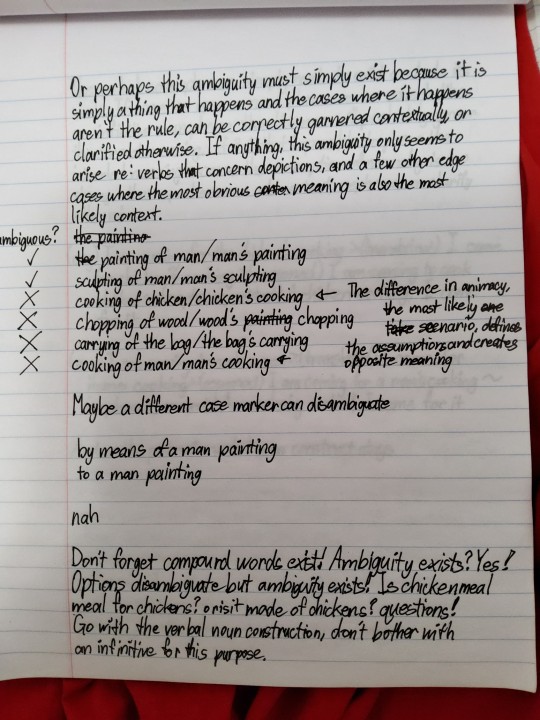
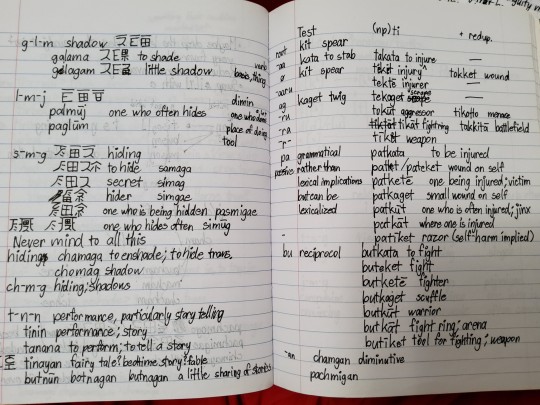


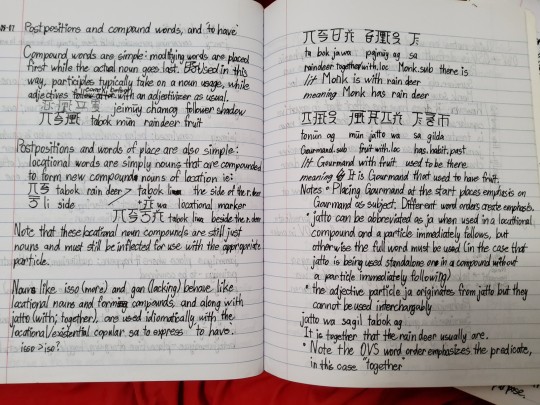
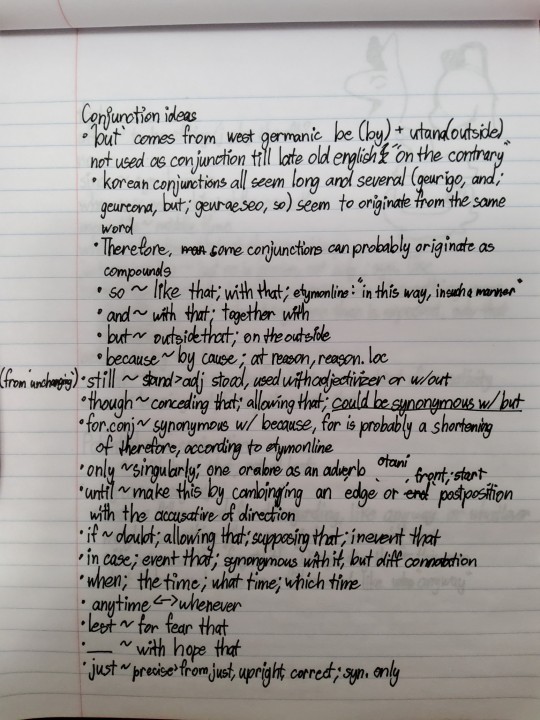


33 notes
·
View notes
Note
In one of your last posts about Matt and Katya, you mentioned Alfred and Ivan’s dynamic, and that perhaps there is more beyond the hate sex they have had.
Do you mind expanding on that? What is your interpretation of their relationship, if it can even be called that?
LMAO god, gonna make me use the two and a half years I spent special interesting my way through Eastern European history on my way to a degree in 20th Century history, are you? About time I did lmao. Alfred/Ivan is one of those ships I don't enjoy purely as a ship, but it's so compelling. Much too compelling to the history to leave out entirely.
So, at the dawn. You have this old state in Ivan, considered backwards and rural by the Western European imperial powers, which has largely lost its verve for even trying most of the time. He has usurped his sister, who built most of their culture and claimed the power he has from the remnants of several cultures and expanded eastwards. And he comes across this young upstart, similarly held on the fringe of the powers of Western Europe. He's had similar obsessions with Jan when the Dutch Republic was new and a lasting one with François when he was the heart of European culture. Moreover, he's not only interested in and admiring of Alfred and the American experiment, but Ivan likes Alfred. Everyone likes Alfred. It's impossible not to like Alfred. There's an affection and attachment, a kind of love if I want to push. By the 19th century, Ivan wished him success because he and Arthur were locked into the Great Game in Central Asia. He spites Arthur, Matt, and Katya by selling Alaska to Alfred when he and Russia can no longer benefit. He's happy to raise a glass to American success. Alfred was touched by the gestures during his Civil War and the purchase of Seward's Icebox.
Afterwards, things declined quite quickly. Between the end of the American Civil War and the beginning of World War One, over 3 million people from the Russian Empire settled in the United States. But less than 5% of them were ethnic Russians. Most are Jewish, Polish and Lithuanian. Feliks mostly stays in Poland, a firebrand devoted to his survival, but Alfred meets Tolys, and he loves him. He lives with Tolys and his memories, perceptions, and opinions. Matt is up to his tonsils in Katya any moment he possibly can be, with a mouth full of their father's loathing of Ivan and a chest heaving with Katya's life. Alfred is increasingly their father's heir. The Pacific acquisition of Alaska was just the first step. If Alfred is the Christ to Arthur's God and lord knows he thinks of himself as a saviour, the Russian empire just looks shittier and shittier.
But he still has that reputation of being an outsider. He's not quite in with the European powers. He brokers the end to Russia's ultimate humiliation against Japan. Ivan, to a certain if somewhat limited extent, believes Alfred's bullshit. The deal is fairer than he would have otherwise gotten. But this is the high point of the pre-war Kiku, and Alfred's strange, tense and intimate relationship and opinion is still vastly with Japan during the war.
Then comes the Russian Revolution and the Polar Bear Expedition. Alfred is keener to do business with Ivan's new government when revolution breaks out. It must be an improvement over the Tsar, surely. He's not entirely in his complete form yet; he gets looped into the Entente's support, but he's pretty vocal about this thin line of hope that this may go well. The way his revolution went. There's this brief moment where Ivan and Alfred look at the world with a thought to a common future. They're looking at each other again with an ancient hope, maybe some mutual admiration. This may work. Maybe Ivan will get his shit together. Maybe Alfred won't become the heir to Arthur's Great Game. Maybe, maybe.
And then it goes up in fucking flames. Even American leftists became disillusioned with the USSR somewhat quickly. He helped lay down new states in the newly free Eastern Europe; God knows Tolys and Matt are doing their best to keep Alfred on-side. It took almost fifteen years, until 1933, for the US to acknowledge the USSR. Alfred is repulsed by the USSR even if he does cool his jets as interwar isolationism has slowed the process of him stepping into the fray as the head of his family.
By World War Two, Alfred is happy to write his redemption story and just dump treasure and materiel at the USSR. He's the balance of power between Arthur and Ivan, and Ivan is delighted to see Alfred snap at Arthur whenever he fucking pleases. But he's also miserable that he is the one dragging himself on his belly over the broken glass and ruins of Eastern Europe and doing the largest share against the Nazis. But there's a little hope that Alfred and Ivan will rule the world when this is over and find common ground in their power. It's only in the waning days of the war when Alfred's clearly suffering from the campaign in the Pacific and Eisenhower lets Zhukov have Berlin, that they shack up in some way or form. Alfred has more hope than Ivan, but Ivan is at least a little satisfied to see that Alfred has had a piece carved out of his idealism by his war against Japan.
It doesn't last. Alfred might be happy to take Arthur down a notch, but when the crown comes upon his head, as has been arranged, he wears it with a certain ease no one expected. Heavy is the head that wears the crown, but what is the weight to a man who fancies himself Atlas and Prometheus all in one. And it comes with the confidence to hate Ivan's ideas and opinions even as he revels in their fucking. Sex isn't love, and the feelings he gets throughout all of it are not love to Alfred. I still somewhat adhere to the thought that McCarthy almost denounced Alfred as both a communist sympathizer and a homosexual in the 1950s for this apparent attachment, but the intelligence apparatus intervened and prevented it.
And that is where I will leave off because I'm damn near at 1000 words RIP.
#I love how I managed to cover only half the fucking century#rusame#Ivan and Alfred || Atomic Hellfire and Nuclear Winter#the ask box || probis pateo
72 notes
·
View notes
Text
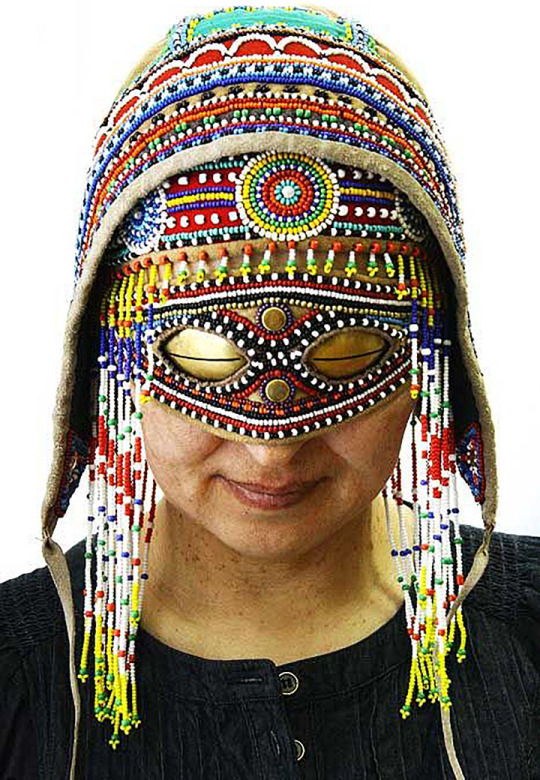



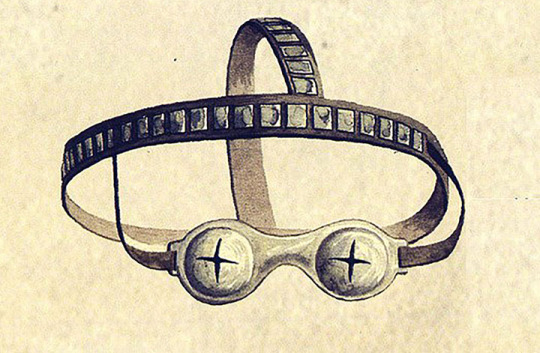
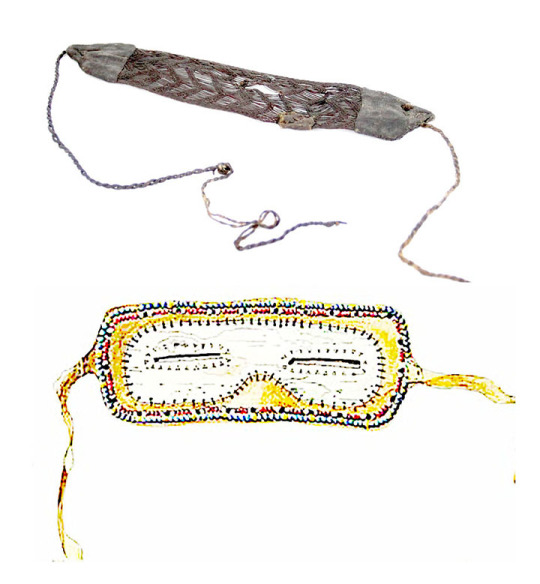


Siberian snow goggles from the Khanty, Nganasan, & Sakha
Toying with an idea here. The concept of the one-eyed Arimaspians has me curious if this was a nickname for people from the north who lived in places where snow goggles may have given the appearance of having a single eye. Given a far enough physical distance and passing through the gossip of enough different languages, by the time this info made it to the Greeks what began as a nickname may have sounded like these people were literal cyclopes. Just a thought. I assume people back then used eye protection from the snow, in some manner, just like people do today. Some of the snow goggles (both modern and historical) do give the appearance of a single giant eye, while others have two eye spots. I wasn't able to find much on this as far as historical info goes, and unfortunately I couldn't find images of the ancient grave finds the article talked about. The oldest of the discovered snow goggles being 2,000 years old from northeast Asia. I'm not sure if the initial black and white sketch is of the ancient goggles or not, the post didn't explicitly say. Below is whatever info I could find on historical snow glasses in Eurasia:
"In ancient times, like today, these goggles were made by skilled masters to combine effectiveness in blotting out the blinding light in some cases looking amazing.
Different ethnic groups across polar regions evolved their own distinctive style in snow goggles.
The most ancient known eyewear belong to the Old Bering Sea culture, the sites of which are located on the both sides of Bering Strait.
The oldest date for the culture - around 400 years BC - was obtained on Russian side, at Ekven graveyard, in Chukotka.
The peak of the culture is considered to be in second and third centuries AD.
At Ekven and also Uelen graveyards snow goggles made of bone were found, dating from the first to the fifth centuries AD.
Some were decorated with carvings, some not, and examples are shown here in these drawings.
Later the snow goggle tradition by Eskimos, for example the Inuits and Yupik, and the Chukchi people.
While there was an obvious practical use for the goggles, a variant of these ‘spectacles’ xxxx is believed to have been used by traditional shamans; for example a pair of goggles without holes of slips was found at Ekve
The Event and Dolgans people turned to metal in making the eyewear with copper or tin or silver goggles inserted into a half-mask made of reindeer skin or other pelt, or, later, cloth obtained from Russian incomers. Decorations with beads was also a feature.
The same type of goggles was also used by other Arctic people such as the Nganasan or Khanty. The British Museum even has some examples.
The tradition continues to this day and is thriving in Yakutia - also known as Sakha Republic, the largest region in the Russian Federation.
Going back in time, the Yakut people used a wide range of materials to make goggles - metal, birch bark, wood, bone, skin, and horsehair.
The goggles created from horsehair comprised strips of intricate net. A surviving 19th century example comes not from Yakutia but Tuva, the mountainous region in southern Siberia, now in a collection in the Irkutsk Museum of Local History.
Most of the metal goggles in Yakut collections are dated from between the 18th and early 20th centuries.
Again, some definitely had ritualistic uses: they were deployed by shamans, and not in everyday day life for use in snow.
Many Yakuts recall that their grandfathers had very simple goggles made of birch bark.
Local historian Prokopy Nagovitsyn said: 'The round shaped silver goggles began to make an appearance in 19th century, when there appeared many rich people.
‘The shape had a symbolic meaning - cross in the circle had been the symbol of the sun since neolithic times.
‘Yet the cross-shaped cuts are convenient not when you are in tundra, but when you, for example, climb steps.’
Most of the older goggles look rather simple - for example a metal strip with the small deepening for the nose and slots for sight. Others have two round metal discs with a slit to see through while blotting out most of the glare; these were fixed into a the mask of skin or fur."
-taken from SiberianTimes
#snow goggles#sunglasses#khanty#nganasan#sakha republic#antiquities#history#yakutia#siberia#arimaspian#british museum
1K notes
·
View notes
Text
Okay so one of the symbols of modern Kazakhstan's independence is Altyn Adam - Golden Man*(as in person).
Altyn adam refers to an artefact that was found 1970 in Issyk kurgan(burial)*.
It looks like this(id in the end of the post and in alt):
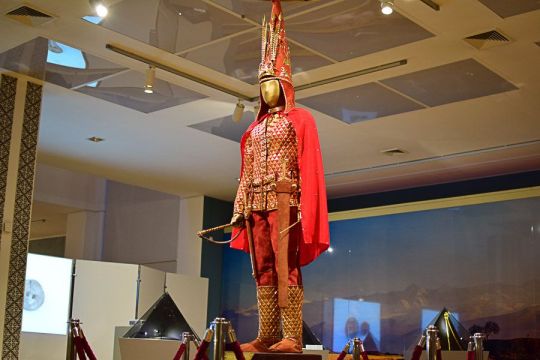
It is actually quite interesting how the artefact was found.
In 1968 the town Issyk became a town and wanted to develop. However, they needed experts to first check that there are no historical sites, which is what they did. For all of 1969 they were carefully uncovering he kurgan, and in 1970 they finally opened it.
It was empty. The place had signs that it has been robbed several times before.
One archeologist, Bekmuhanbet Nurmuhanbetov*, decided to check some 30-40 meters away, and found a side-burial which was left untouched since 6-5th century BC.
They found so many artefacts that listing them all here would be quite difficult.
What I would like to mention though is who was buried here:
Gender is unknown*, but the age is around late teens(16-18)
The person that was buried here was most likely to be a child of some kind of tribe leader, because their burial is smaller than the main one.
About the tribe! The burial probably belonged to Saka tribes. Saka people might relate to Scythians(they are probably part of the same cultural group?)* *. Anyways this particular kurgan was made by Tigraxauda people. Their name derives from persian and means. Pointy hats........
The golden armor is probably more ritualistic(haven't seen it in direct text sorry) than anything because the golden pieces of armor are wood covered in golden leaf. The helmet is made from golden plates though.
There are actually some interesting thing that are present on the helmet. By that I mean the arrows, which are said to symbolise 4 parts of the world. There are also multiple animals* on it. As a whole the costume consists of 4000 golden pieces.
And finally, Why is it so important?
Well to answer this question, you should know USSR's relationship with history and how is was teached in Kazakhstan specifically: mainly, world history through the lense of revolution and how Kazakhstan just sorta became part of USSR after it was Russian Empire's colony*. Nothing before that as people that lived on this land.
Which led to a very hard situation after the independency was gained because well. The majority of people were Kazakhs, but a lot of culture and identity was lost. And part of it was history.
So an artefact this old brings a sense of legitimacy. It also doesn't hurt that it's pretty.
ID and notes under cut
[ID: Armor on a mannequin in a museum setting standing above camera. The mannequin is wearing long-sleeved jacket which is a mix of red fabric and triangular golden pieces. The same pattern is on its boots. The pants are made from a red fabric. It is wearing a very large conical headpiece almost as tall as its chest(40cm). It is very pointy. The headpiece has 4 golden arrows and some animal ornaments on it. The figure has a bow and and an arrow in its hands, and a sheath for sword and another weapon on its belt. It is also wearing a red cape just reaching its thighs. ]
* Actually there are several artefacts like this! Around 6 or so which were found in different regions at different time. All of them are called golden men, just the place that varies. This one is Issyk's Golden Man. Some of them are actually made from solid gold and not gold leaf which I find fascinating.
* Ok so kurgan is used interchangeably here with burial. And in a way kurgan is a burial. It is also in a way like a pyramid? There are things left for the dead so they can carry them to the afterlife, but the kurgan itself is built a bit in and above ground. The rooms are made from logs, and then covered with dirt to create mounds. I also heard that a herd of horses would run it over a bunch of times to set the earth.

*Full name Bekmuhanbet Nurmuhanbetov Nurmuhanbetovich. He eventually organized a museum for the kurgans he found. He died in 2016, at the age of 81, and for some reason he has "Bekem-aĝa"(aĝa means older brother, uncle just an older friendly male figure) as his pseudonym on his Wiki.
*Actually Saka seem to had been pretty great about equality. There is also a very cool story about their female chief Tomiris.
*Historical records about nomadic people come exclusively from settled ones. Because a lot of stuff they would probably write on(despite the claims about lack of writing system) would't have survived because you know. Nomads.
*Haven't mentioned it in the post but sometimes Saka people are called ancestors of Kazakh people and uhhhh. They are probably more related to modern Europeans than to us. They still had similar lifestyle and lived on this land though. And they were more mixed than anything because you know, race is bullshit.
* Oh also fun fact one of the animals is a tulpar which is a horse with wings. The same mythical animal is present on Kazakhstan's official coat of arms.
*should I keep making these notes? because I feel they might take away from the flow of the text, and some details are simply not that important or I cannot convey them properly. so. what do you think?
#the whole legitimacy thing is of course not just kazakhstan#every country out there is doing it tp build a cohesive narrative that people can unite around#kazakhstan#kazakh#kazakh culture#kazakhstan history#kazakhstan politics#kazakh history#Kazakhstan culture#ussr#history#asia#central asia#cw: mention of death#what warnings should I put?#ussr culture#ussr education
63 notes
·
View notes
Text
I know my following is small, and everything was already said, but I just wanted to say something.
Just so y’all know, this is probably gonna a be long post ->
———
I as a lot of people love qsmp for it’s magic of getting people from around the world speaking and forming friendship together. And learning each other’s cultures in such a different ways.
I know I’m probably not the only one, but I’m not someone who’s from English speaking countries (America and such), I been always ‘forced’ to use English if I needed to buy or talk to someone in online spaces. And even if my culture is not that massive as others i know the pain of being made fun for my language or even country.
It’s been a lot of times I been called Russian, and getting sexualized for my looks and our countries history with them. Or people not wanting to learn and forgetting my own countries existence.
When Quackity started to stream more in Spanish I felt happiness and even if I didn’t understand him, I still tried to look for translation but only found angry comments how he should talk in English, and stopped talking Taco Bell. (I will never forgot these ‘jokes’ I know it’s hard for people who don’t know the struggle, but it still feels really disrespectful…)
But seeing this project showing people the magic of others culture, even if mine wasn’t there… I felt loved.
When Chayanne showed Germans traditions that was really similar to mine, I felt happiness at the way everyone loved it.
When new people showed up and everyone tried to learn how to say hello in their language or didn’t spoke English and used the translation instead.
I love seeing how all of their English got better or the ability to try to learn different languages even if there’s translation available.
—
I love this community and as someone who loved dsmp I really know how much this hurts.
But don’t worry! We still have each other, we made art and expressed what made it all even greater then it already was. I really appreciate you writers, artists, people who do cosplay and even people who didn’t had the courage to interact publicly in the fandom like me until now.
And the most important the Admins! I really appreciate you and what you did, even if its only giving life to ‘characters’ you played. You helped me with sadness I been feeling for while, and i think I’m not only one who said this but I wish you the best of luck on future projects, even if you decided to never interact with qsmp again.
I loved and still love this community we made, even if it had it’s downs and ups.
I will not leave, but I will try focusing on my own mental health and everyone who needs it.
I’m not comfortable with venting but if anyone just wants to talk about fanart or just have their mind on something else, feel free to dm me! I’m really bad at this, but I know it’s hard if your someone who didn’t interact online or doesn’t have irl friends or someone to talk this through with.
I know there’s probably a lot of grammar mistakes but I just wanted to share my love to everyone who was really feeling down with all this stuff happening.
I love you qsmp and even if this is the end or the new start. ❤️
#qsmp#qsmp discourse#qsmp discussion#qadmin situation#thank you quackity#thank you every admin that helped this project grow#thanks everyone here#I’m from Czech Republic if anyone wants to know why I mentioned being called Russian#i know it’s not that deep#but it really hurts#hyperfixation#qsmp admins#quackity
26 notes
·
View notes
Text
ok guys, no jokes, but what the fuck?
i want to touch a really really serious topic in pink floyd fandom rn and i want you all to listen to me at least once. i would really appreciate it if you spread this information. thank you
if you're the type of person who writes "well, waters is still better than gilmour", then just please unfollow me forever the fuck out
but it's ok i'll explain you why
well, a little backstory
while many believe that roger's political views are now quite correct, i want to remind you that he supports an aggressive invasion of the country where i live (Ukraine). if you are still interested, then yes, the war in Ukraine is still going on even if in the west now no one wants to pay attention to it anymore. for your understanding, on average we have 100 air raids in the city per month, at least once a week i definitely hear explosions and, yeah, i don’t live in a hot spot. and this guy just goes out and does an interview where he openly says that he supports the aggressor country. yeah, that's right, he was also allowed to speak at the UN council, where he said that the conflict was provoked. very smart. the same guy who said a couple of days before the war that those who believe that it will start are “out of their minds”
ok ok, but how does this relate to gilmour?
very simple. his daughter-in-law is Ukrainian. and her mother lived in a city that was one of the first to be attacked by the russian army. if you have never seen footage from Kharkiv in the first days of the war, then believe me, it was a terrible sight, people tried to help each other as best they could
and it is still going on
i don’t think it's cool to talk shit about one person who supports israel but then turn a blind eye to how another openly says that Taiwan should belong to china and Ukraine to russia and say "well, he is based", "he's better than gilmour"
if you have any other information about gilmour, you can share it with me.
i know you all really like young waters and i see a lot of positive things in him too, but i really can't stand the fact that now people only really look at how he feels about Palestine, even if i see a lot of articles and posts from adults, who say his support for Palestine is also twofold. don't wanna say anything bad about that because i haven’t studied this topic, but i think you can google them yourself, they always just come up
don't get me wrong, i'm not stopping you from sending pictures of him or drawing him, i'm just asking you not to write that he's better than someone else at something when he's not
oh yeah and one last thing...
if you are a supporter of communism, then get the fuck out too, because communism led to the fact that in the 60s in my country they killed almost all the poets who did not write something in support of the state. in history they were persecuted and killed because they wrote in their native language and mentioned Ukrainian culture. communism led to three great famines in our country, when people had so little to eat that they resorted to cannibalism. it's very scary, but it's true. this is what the government has led to when it wants to bring communism to life
communism is not a cool thing. it's cool in words, not on practice, read history
thank you for your attention
26 notes
·
View notes
Text

“Looking from East to West in the 90s, like Alice through the looking-glass, one could feel as confounded as the residents of Animal Farm. The Russian premier Boris Yeltsin spent the 90s spearheading "shock therapy" for the former Soviet Union. This process of economic liberalization, privatization and asset-stripping led to the concentration of wealth and power in the hands of an oligarchic elite, leaving the rest of the country to impoverishment, psychological shock, endemic organized crime and corruption. To the benefit of its leaders and the detriment of its people, the East became a mirror-image of the West's worst excesses. The Manics' critique of Western capitalism and its turbocharged adoption by the East, allied to their lack of faith in the practical application of communist ideology — though not the ideology itself — makes "Revol" an extension of the axiom of post-communist cynicism which states that Soviet leaders "were lying when they told us about communism, but were telling us the truth about capitalism."
The Manics' use of Soviet imagery in a post-Soviet world was not new, but The Holy Bible, with its lyrical preoccupations the band's adoption of military uniforms and the semi-logo of a Soviet war medal, saw it become something more definitive. How much of this was aesthetic opportunism, and how much politically earnest? Like the Manics, I grew up in impeccably Old Labour territory and, way before discussions on how to be a fan of problematic things, remember being starry-eyed about the Soviet Union. Any yearning for the USSR, though, had less to do with the reality of its final days and more to do with its symbolic opposition to a Conservative regime which was then laying siege to the industry, economy and community of my part of the country. I looked East in the way one might look to the stars in the hope of arbitrary rescue by occupants of interplanetary craft, with expectations about as realistic.
What had been a source of fear and fascination in the 1980s was, in the postmodern vacuum of the 90s, safely powerless and therefore kitsch. Fascination with the communist past — dubbed Ostalgie — tended to be denied any political dimension, allowed to manifest only in ironic or mocking forms, and very rarely linked with contemporary anti-capitalist critique (Pyzik, Poor). The Holy Bible's suffusion in Soviet chic, though, had more to it than ironic recuperation. Nicky Wire, when asked, "What do you think makes sense?", responded: "Certain kinds of socialism, where everyone is given a chance. A true egalitarian society where everyone is offered an education." As basic and uncontroversial as this is — and note the cautious "certain kinds" of socialism, pre-empting the conflation of socialism with Stalinism — it highlights the band's commitment to keeping the idea alive in politics and culture. The later Manics' Labourism appears almost uninterestingly mellow in comparison to The Holy Bible's morbid fascination with the extremes of Soviet communism, but neither approach denies the contemporary relevance of political history, or presents it merely as kitsch.” - Rhian E. Jones, ‘Unwritten Diaries: History, Politics and Experience through The Holy Bible’ [p. 76 - 78]

“Ballard, Saville, The Holy Bible all use shock tactics, aesthetics of gorgeous abjection to assault the viewer. Ballard does it with crashed bodies and psychologies smashed to shards; Saville with bloated bodies out of control, tragic flesh of saints, sanctified for their suffering with no meaning, of no purpose beyond the physical carrying-through of their existence. The Holy Bible does it with its ruptured squabbles, soul sores leaking pus of humanity's capitulation to the dark side, rotten missives, accusations, breakdowns and weaknesses, as if it can't stop shaking anymore.
All three want to make their mark on you, perceive their own mission as one of violence upon the spectator: a moral mission because amidst all the white noise and static of the information-entertainment world, the jeering is too loud, and the crying is all but drowned out. In the service of truth, the artist must lacerate, and the profound abjection of the body, the scarification of the self, the breaking of the taboo of the illusion of sanctity of the body as self-contained whole, is a perfectly acceptable way for encroaching on the complacency that allows us to live complicit lives. Aesthetic butchery is thus a moral enterprise. Obscenity, critically modulated, pulls you out of your comfort zone and makes you confront yourself, or at least the parts you hide daily in order to live in polite society and in good conscience with yourself.” - Daniel Lukes, ‘Fragments Against Ruin: The Books of Manic Street Preachers' The Holy Bible’ [p. 226, 227]

“The present absence of Richey endured even through the years immediately following his disappearance, when the band was most vociferously separating from their past. Speaking in 1996, Nicky stated, "We'll never fill that gap. We'll never get anoth er guitarist. James will never go over to that side of the stage" (qtd in Maconie, "We Shall Overcome" 88); the space of stage right became a sacred site of remembrance for the band, but also a heightened, present absence for fans. In the documentary for the tenth anniversary edition of The Holy Bible, James describes his discomfort whilst playing Reading Festival in 1994 as a three-piece (at this time, Richey was hospitalized), which included the fact that some of the fans "were staring at the space of the stage where Richey should be, refusing to look at me." This desire to look at the empty space usually occupied by an object perceived as valuable is arguably an expression of the connection between emptiness as an index of a sign that holds symbolic meaning; the absence ironically brings more meaning to the surface than was originally recognized in the object itself. In his discussion of the spectators who flocked to see the empty space in the Louvre from which the Mona Lisa had been stolen in 1911, Darian Leader posits that this incident makes manifest the split between art and the space it usually occupies, thereby prompting an interrogation of the usually unseen or hidden meaning in the artwork that typically isn't in question. In becoming a signifier of totemic mythologies of tortured genius and martyred rock stars, Richey's absence became an index for that signifier, whereby spectators intuit meaning even by staring into the void of the lost signifier. These mythologies then perpetuate a kind of lovely knowledge because they fit into an already established perspective and narrative of popular culture. Within the last twenty years, the proliferation of music magazine covers featuring Richey have played into this lovely knowledge, rather than confront the difficult knowledge his disappearance evokes.” - Larissa Wodtke, ‘Architecture of Memory: The Holy Bible and the Archive’ [p. 302, 303]
All passages from Triptych: An Examination of the Manic Street Preachers’ Holy Bible (2017)
#manic street preachers#holy bible#revol#communism#socialism#soviet#soviet union#soviet kitsch#ostalgie#chic#stalinism#nicky wire#richey james edwards#richey edwards#richey james#james dean bradfield#sean moore#triptych#rhian jones#wales#pyzik#agata pyzik#poor#poor but sexy#daniel lukes#larissa wodtke#ballard#jg ballard#crash
68 notes
·
View notes
Text
Superfluous writing update
Calling this superfluous because it's about a story I've decided not to publish, but it's a writing update nevertheless and while I'm deeply dissatisfied with the result, I can still use it for my YOI canon/post-canon series.
The (first) draft of my Vitya backstory, which I've started writing during my Easter holiday, is finally finished. A part of me kept hoping that I might change my mind because it had some highlights like the origin of the bondage lilac fairy, but unless I invest an unholy amount of my time in the revision, it's not going to become a story that anyone would be interested in reading because for all I know, it doesn't match people's expectations about Viktor's past at all. In addition to that is this draft a big construction site.
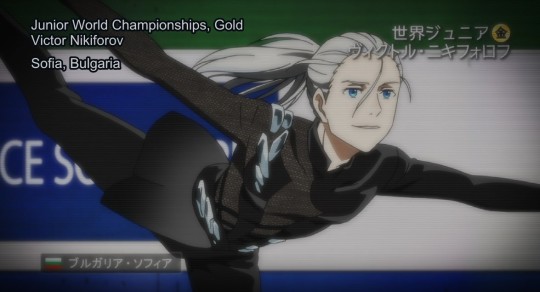
Here's what imho makes the story unappealing and/or screams at me to be fixed:
Baby Vitya obsessing over a late famous Russian ballet dancer, who I thought would be an amazing idol for him and inspire him to become the kind of skater we see in YOI - no actual story here, just a loosely connected series of events.
Early teenage Vitya still obsessing over his ballet dancer and experimenting with feminine styles and being very stubborn about it despite everyone criticising him - still no actual story here, though, and his arguing with Yakov is becoming repetitive.
A very lenghty part about his first love that was mostly self-indulgent because I knew I had to end it eventually - actual story here for once, but let's be frank: who does even want to read 8 chapters about Viktor/OC?
A first Olympics that very likely is not at all like what Sayo and Mitsurou had in mind for the movie because my Vitya is still trying to get over his heartbreak. Note that I never aimed for that because this project is the result of smaller details I've invented for my series, but the result is far from what I had in mind and although that's part of a natural writing process, the result is extremely dissatisfying.
No drama revolving Viktor's decision to cut his hair because I believe that it was just him getting tired of his long hair and reinventing himself/crafting a new persona.
Poorly fleshed out programmes (there were just too many and I was too busy jotting the story down).
Appearences of real-life figure skaters who competed at that time because I was too lazy to invent OCs for anyone who is not Stéphane Lambiel.
Poorly researched Russian culture (I was too preoccupied with turning post-Soviet Russia into a country that is compatible with the world of YOI than looking into such details).
No teenage Viktor meets teenage Yuuri because during the time the story is set, they never skated in the same category due to their age gap: when Yuuri discovered Viktor, he was 12 and Viktor on the verge of entering seniors, and by the time the story ends, Yuuri has just reached the minimum age to enter seniors.
Honestly, I don't see the appeal in any of this, even if I fix the issues, shorten the lenghty parts and connect the scenes in the first half to an actual plot. It will take months until I will have time for such an endeavour and it will take even more months to turn this clusterfuck of a draft into something readworthy, and by then here will already be dozens, if not hundreds of Young Vitya stories written by people who will likely do a much better job at it than I could ever do.
Why is that even important to me? My stories are very dear to me and posting into the void just hurts. So far, I didn't have any luck with stories that are basically Viktor without Yuuri. This one was especially precious to me because it's a coming-of-age/coming-out story. Since the movie was cancelled, I also feel that expectations for this kind of story have skyrocketed because YOI fans crave to get their Ice Ado in one or the other way. Last but not least, this draft needs an unholy amount of work, and given all the reasons I've just listed, it just doesn't feel worth the effort at all.
So yeah, I wrote a story I've been burning to write since I had the idea back in January, and for the first time in 15 years of writing fanfiction (and 10 more years of writing), I've fucked it up. I now have 115k of backstory I can use in my ADTLTBA-series to flesh out Viktor, which is ridculously much for a backstory. On the pro-side, I now can rest assured that this story will never be abused to hate on animation studios and I'm just emerging from two very intense weeks of writing, which I haven't had since last NaNoWriMo.
#yuri on ice#yoi#viktor nikiforov#jen's mind vomit#writing#fanfiction#my yoi fanfiction#ADTLTBAverse
14 notes
·
View notes
Text
So, finally, the continuation of this post here.
The first thing I want to say is that I was pleasantly surprised at how many people actually liked the previous post and wanted to see more - so thanks so much to all of you, I've never thought that so many people would be interested in me talking about the design and my country's culture🩷 (and yeah thank you @signanothername for your kind words again)
I'm sorry this post took so long, but I actually struggled a lot with Nightmare design. Everything just felt wrong for some reason and I literally couldn't finish it. I even took a break at some point, and it actually worked in a surprising way.
You see, I like the Dream design I made previously. But I always felt like something was missing. The design was beautiful, and the different ornaments actually had meaning that fit Dream well, but it was lacking... a story? Like, it wasn't completely accurate, and I could really imagine a person looking like that living somewhere in the ancient Russia, walking in the streets. It was a good representation of different russian cultural elements, but that was the only thing that it was really.
So instead of thinking what russian culture elements can I include in a design I started thinking about a completely different thing.
Can I possibly imagine the dreamtale brothers in the setting of Russia in the past? What would they look like? How would they live? Can I somehow "adapt" their powers and turn them into something more related to the russian culture of that time?
And well, I made a completely different concept with completely different designs.
Now, I wanna say that this post still contains an enormous amount of text, but know it's not only about the russian culture, but mostly about the kinda au that I made? It's still in the development, I'm still thinking about the details, I mean, I haven't even got a proper name for it yet... But I just haad to write about my thoughts and share some artwork that I did so here we are.

The whole thing is inspired not only by the russian culture, but also by the Black Book game which I mentioned in the 1st part and which gave me a general direction of where to go with this.
So, the setting is somewhere around the 19th century, in a quite ordinary russian village. Both Dream and Nightmare are children from a family of villagers. Here are some examples of 19th century russian villagers clothing that I took inspiration from:

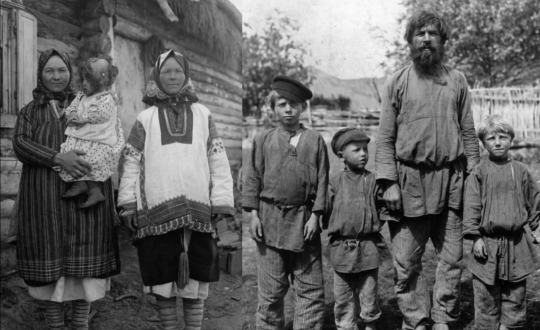
At first it looks quite simple, but it has some interesting small details and looks quite unique:)
One of the reasons I chose 19th century is that despite being quite a "modern" time, with different new technologies and overall progress it was a time when many russians (especially in villages) still believed in different myths, sayings, tales and epics. Russian culture and mythology still played a big role in ordinary people's lives, changing and transforming through the minds of different people to better fit the ever changing reality and new technologies being introduced. Russian paganism, orthodoxy and local beliefs finally began to coexist organically with each other, in some ways even blending in together creating some unique traditions, customs and overall culture.
So now, about their magic.
One of the questions I asked myself was: What kind of magic would Dream and Nightmare wield if they lived in the traditional old russian village settings? Was there even a concept of "magic" in old Russia that could be suitable for the brothers?
And while I can't say that I've found a perfect alternative, and what I'm about to tell you might seem not fitting at all at first, I think the concept I'm about to show and especially the idea it can convey is not that far from the whole "positive and negative emotions" thing.
So, as it turns out, the concept of magic or paranormal abilities in old Russia is quite unique and different. There actually were people who were considered "magicians", or rather witches and withchers, but. The whole idea of magic itself was tightly connected with different mystical creatures that inhabited the whole country in minds of russians (and there were many. like MANY) and the ability of a person to talk with them, connect with them, correctly perform various rituals related to them and basically ask them to do certain things.
In other words, a witch or a witcher in old Russia is not a person inhabiting magical powers all by themselves, but a person who can "deal" with spirits and mystical beings of different kinds, ask them to do the magician's biddings or help them in a way needed.
And let me tell you, there are many different types of beings, creatures and spirits in russian culture, all of them fulfilling their own purposes. There aare the classical spirits of the forests, of the rivers and lakes, but we also have creatures living in people's houses (spirits that look after the well-being of the house), beings living in every banya (a small russian bathhouse located near the house), spirits of field, arable land, sowing season, winds (northern and southern separately) and many more. And don't get me started on the evil spirits and different types of demons like bisi and chorts, that's a whole another category.
What I've noticed is that the different beings of russian mythology are mostly either the ones connected with nature, like keepers and protectors of forests, lakes and etc, or the so called "evil spirits", different types of demons and devils or other beings that are overall considered dangerous, which are often portrayed to have connection with human routine and different temptations and sins.
And well, here comes my idea and the whole concept. What if Dream had the power and natural talent for connecting with the different spirits and beings of nature, while Nightmare had the natural talent for connecting with the so-called "evil spirits".
Maybe you already think it's fitting, but wait, there's more. You know, I (and probably many others) always thought of positive and negative emotions as a neutral concept. Emotions aren't bad or good themselves and both types can lead to good or bad things depending on the situation and the person who is experiencing those emotions. Guess what? (And I was surprised too when I found out during my research!)
There IS a similar concept with the russian mystical creatures and magic wielders. While people who can connect with "evil spirits" were quite often viewed in a more negative light (like the situation with negative apples and Nightmare), those people could (and actually did) use their abilities and knowledge for good purposes! Of course there were people who used such abilities for their own gain and evil deeds (especially when there was always a threat of being tempted and corrupted by the forces such people were working with). But there were other uses for such powers, people like that could help and save people from the evil spirits, tell them what to do to avoid getting "on the bad side" of dangerous beings, cure people from different illnesses and being possessed by demons, etc. For example, while it was partially done out of fear of a witcher rage and revenge, people used to invite people who had connections "with the darker powers" on their weddings so that they can protect the important event from different kinds of dangerous beings and spirits, to protect newlyweds from various misfortunes in their future life together. Even shepherds were believed to have connections with different kinds of low rank demons, and used them to watch over the herd, prevent other evil beings from stealing the animals.
On the other hand, the practice of talking to and performing various rituals involving spirits of nature was viewed more positively, since it was mostly used to please such beings and ask them for a good harvest, catch off fish, successful hunting, safety during travels and etc. But such powers could also be used with evil goals. Such people could easily affect the weather, cause different natural phenomenon and even poor harvest and famine.
So, we have a situation where there are two types of powers that are overall kind of similar, are actually completely neutral by themselves, can both be used for both good and bad and completely depend on the user, but one power is mostly viewed positively while the other is considered to be rather dangerous and evil. Yeah, I feel like I've seen that somewhere.
Now, let's talk about Nightmare and Dream separately (and the children designs I made for them)
Starting with Nightmare:

• She/her in this. I don't know why, I just see Nightmare as a girl in this and Dream as a boy. She is also inspired by the main character of Black Book who is female, sooo
• She and Dream were born in a small village in a family of a skilled hunter and a powerful witch, who wielded a mysterious artefact - a book containing a huge number of spells, rituals, descriptions of various creatures and other knowledge. She was able to connect with both types of spirits and beings and often helped the villagers out. Unfortunately, while there were no problems during the birth of Dream, the process of giving birth to Nightmare was hard and the witch passed away soon afterwards.
• As already mentioned, has a natural talent for communicating with "evil" and "dark" spirits and creatures. The villagers already thought of her as cursed since in their minds she was the reason the village's beloved witch died, and when they found out about her dangerous abilities (especially since connecting with dark spirits was considered a difficult art that people learned and studied, and being born with such ability on a good level was rare), well yeaah, she doesn't have the best reputation.
• So, this is actually a cool one imo. When I was creating this whole mess in my head I thought that them being named Dream and Nightmare was, well, not the most fitting and authentic for my traditional russian au thing I'm trying to do... So I thought that maybe I can find them some cool ancient russian names that have a meaning suitable for them? And I did. So they have ancient russian names now too! So, the original Nightmare's name (the one her mother gave her) is Tihomira (Тихомира) or Mira (Мира) for short, which means "a calm and quiet, reserved person".
• But eventually the villagers gave her another name (more like a nickname) - Zloba (Злоба), which literally means evil and malicious :'(
• She was always surrounded by rumours about her and the death of her mother, she obviously doesn't remember her mother but misses her dearly, she always looks at photos of her parents together with eyes full of longing.
• Her and Dream's father shuts down after the loss of his wife, he's rarely at home at spends most of the time hunting, Mira has to stay at home to work around the house most of the time.
• In search for explanation of her abilities, as well as trying to prove to herself that she's not the cause of her mothers death, she actively seeks out all the different object, photos and painting, anything that once belonged to her. And one day, she finds the book.
• By the way, unfortunately, the father doesn't really like his daughter too. Sometimes he looks at her and really struggles not to see the reason of his lovely wife's death in her. Actually he knows about Mira's slight obsession with her mother's things, he finds it unnatural and even creepy, he tries to hide all of the witch's belongings, especially the book, thinking it can be really dangerous in Mira's hands. Well, she finds the book eventually anyway.
• I know that some people don't really like the canon concept of Corrupted not being Nightmare but rather a completely different being. I don't like that too, but I don't want to completely get rid of Corrupted as a character, so they are both present in this story as separate characters, Corrupted being an evil spirit sealed in the book (you can see him in the background of the art).
• At first Mira tries to use the knowledge in the book to prove to the villagers that she can also do good with this power, but the book eventually influences her and corrupts her.
• The apple incident is now the book incident :/
• Corrupted and Mira remain to be separate beings even after the incident, although they heavily influence each other, I'll probably talk about the incident and what happens after it in the next post after this, I still have to develop their adult designs too.
Now I'll give you a couple of examples of different creatures this Nightmare can interact with:
Actually, I need to put a warning here for descriptions of gore, death and violent actions since russian mythology is not just a couple of happy fairytales an can actually travel to some dark themes, so be warned ( if you don't want to read just skip to the Dream part)
1. Kikimora:
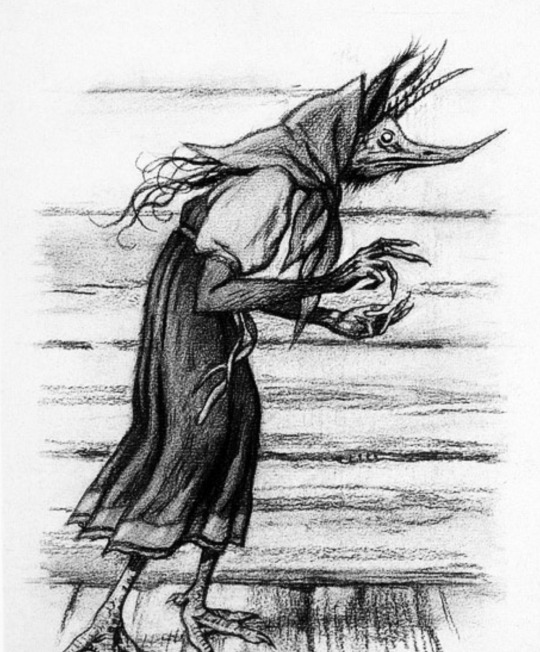
Kikimora was described as a short, crooked, slovenly and ugly old woman, a long-braided girl or woman. According to various other descriptions, a kikimora can be very small and thin, with a large head, long arms, short legs, bulging eyes, hairy paws, horns, a tail, and covered in feathers or fur.
It was believed that Kikimora could appear in a house after the death of one of the family members, but she could also be sent into the house by a witch or a witcher using a ritual artifact in the form of a small doll.
It was commonly believed that kikimoras cause great harm to people and can be dangerous: they prevent them from sleeping and frighten them with various sounds, annoy small children, pounce on and strangle them at night, throw various objects, drop and break things, pull out or cut out hair from people, wool from cattle, feathers from poultry in their sleep. The activity of kikimoras could even force owners to leave their home. There are stories in which kikimoras brought people to death.
Kikimora's favorite tool in the house is a spinning wheel. At night, Kikimora often spun, making a lot of noise; any things spun by her were considered cursed. If the owner of the house noticed Kikimora doing this at night, it could be a sign of imminent death. Most often, people did not see this spirit, but they heard her noise and felt her presence; it was possible to drive her out of the house only with the help of strong spells and rituals performed by a witch or a witcher.
2. Likhoradka (fever)
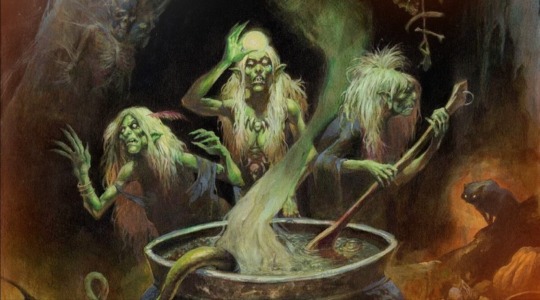
Likhoradka (which means fever in russian) is a disease personified in the form of a woman in russian mythology, invading a person and causing either chills or fever.
A distinctive feature of Likhoradka is her multiplicity. Most often, this spirit came in the form of several women at once (7, 9, 12). It was believed that Likhoradka crawled under a person's skin, causing illness, and after the death of a person, it jumped into the body of another. Likhoradka spread very quickly, sometimes taking many lives throughout the village. She can be driven out either by strong spells or by curing all the sick with special decoctions. If Likhoradka was driven out, then most often it was "sent" to the forests, fields, swamps.
3. Bannik and Bannica
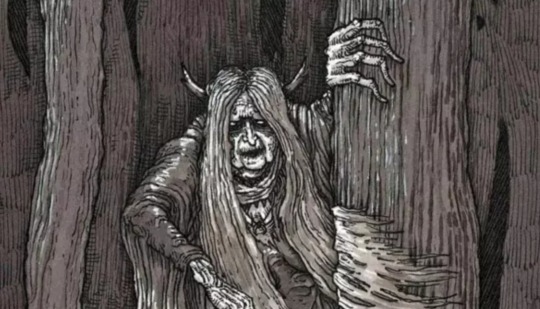
Bannik lives in the banya ( russian bathhouse); usually invisible, sometimes takes the form of an old man covered in dirt and leaves from a broom, or a man with long hair, and also turns into a boar, a dog, a cat, a frog, a white hare. A female Bannik is called a Bannica, or an Obderikha. An Obderikha is a shaggy, scary old woman.
In general, Banniks are quite peaceful spirits, but only if a person follows all the rules during a visit to the bathhouse and does not forget to make offerings to the spirit. To appease Bannik, people leave him a piece of rye bread with a large amount of coarse salt, and also leave some water in the tub and a piece of soap nearby.
If a person angers the Bannik, he turns into a dangerous and malicious spirit - he can burn people with boiling water in the bathhouse, throw stones at them, and also knock on the wall, frightening those taking a steam bath. If a person has violated very serious prohibitions, the Bannik can cause great harm: he can peel off the skin or steam a person to death. People often came to witches for advice on how to properly appease the spirit, what should and should not be done in the bathhouse, and also asked for help if the spirit was angry.
Now let's talk about Dream:

• He/him
• His russian name is Peresvet (Пересвет), or Svet (Свет) for short, which means "the one fighting for the light". I know, it's really cool😅
•As mentioned, has a natural talent for speaking and connecting with different spirits and beings of nature.
• The villagers though of him quite well, especially compared to his sister. When they found out about his powers, they started to value him even more since he could help out villagers and perform various rituals which would bring a good harvest, protect crops, bring good weather, etc.
• He actually has sort of a hobby collecting different plants he find beautiful, one day villagers started noticing that all the flowers and plants he bring are actually either medicinal herbs that are good for curing different diseases or are used in some useful rituals. It's actually not because he's just lucky, some spirits of nature are actually helping him find them from time to time. It's after many such occurrences that the villagers started suspecting about his powers.
• Opposite to Mira, Svet is almost always outside, either just playing with other children, helping villagers with his powers or learning more about them.
• On the contrary to his sister, is not really interested in developing his powers or learning more about them and all the rituals, he mostly wants to have a simple happy childhood like other children, he also dreams of becoming a simple herbalist in the future, not a witcher, but he feels like he has to do all that to help the villagers and be a good person, so he tries his best to practice and study anyway.
• Is actually quite close to his father, well as close as you can get to a shut person like him, sometimes the father takes him to some walk in the forest with him, he tells him about different plants in the forest and how to properly survive there since he's a hunter. Svet cherishes such rare interactions quite a lot.
• Doesn't understand his sister's troubles and doesn't spend much time with her, the villagers are always demanding him to be outside, to help with some rituals or collect some herbs. But he actually wants to spend more time with her, he just doesn't know how to say no to the villagers.
Some examples of the spirits Svet can connect with:
Actually, there are no descriptions of gore here or anything, but some darker themes like death and being lost are present so please proceed with caution
1. Leshy
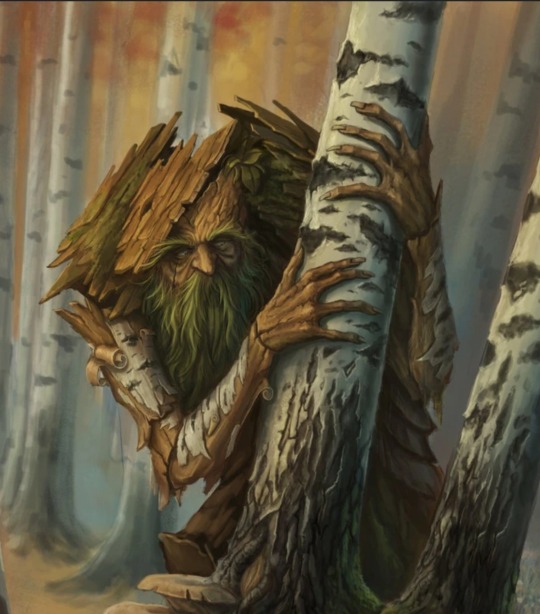
Leshy is the spirit-master of the forest in russian mythology. In mythological stories, Leshy appears as a plant, animal or anthropomorphic creature. It is also common for the leshy to appear in the form of relatives and acquaintances. The leshy was sometimes described as a giant, sometimes as a dwarf; there are beliefs that he could change his height.
As the master, the leshy takes care of the forest, protects it, and is the patron of forest animals and plants. The leshy was considered a fair master of the forest, who would not harm without reason, but could punish people for inappropriate behavior in his domain, or if a person behaved,he could help them. According to popular belief, the leshy could ensure good luck in hunting and safe grazing of cattle, but for this to happen, hunters and shepherds needed to make an agreement with him.
Such an agreement was called a "forest charter", people (usually with the help of a witch) wrote their requests on birch bark, asking Leshy to help in hunting and not to harm the village. In order for Leshy to accept such conditions, he was appeased and brought offerings: various foods, bread, milk, sometimes coins. However, Leshy punished people who violated the forest's prohibitions - he could kidnap them, make them wander and get lost in the forest, from where people rarely returned and usually died wandering in the forest.
2. Gamayun
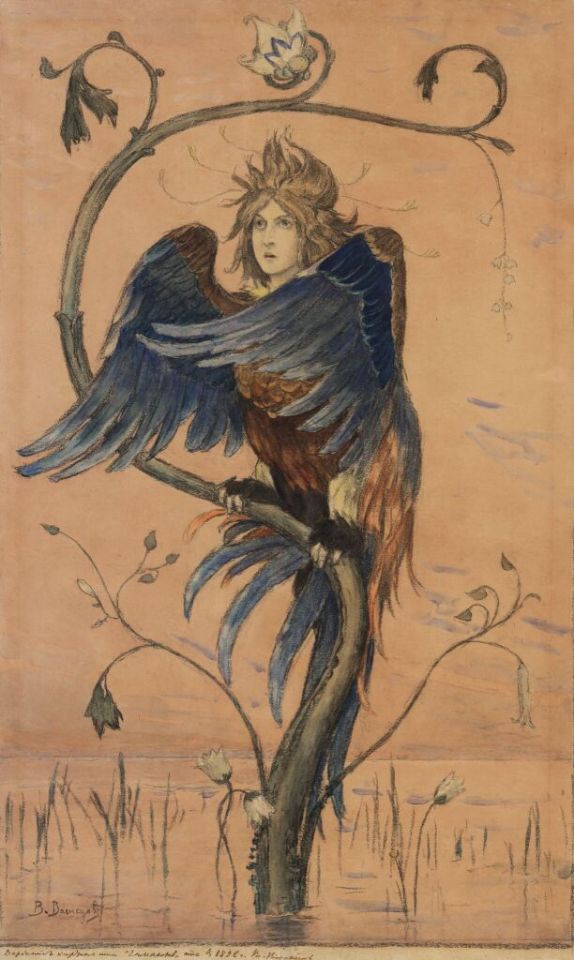
Gamayun is a mythical bird of paradise in Russian culture. In literary works of the 17th-19th centuries, it is a bird that flies in from paradise and flies forever with the help of its tail. In the culture of the 19th-21st centuries, there were two main directions in the development of the image: as a bird of paradise, which is associated with ideas of happiness and bliss, and as a mythical bird that foretells trouble. Depending on which side it flies over a person's head, either luck or misfortune can await them.
...
Yay, I actually found some time today to finish this! Of course that's not all, and I have a lot more to tell you: about the specifics of russian spells, about the book, the incident and what happened after (I still need to do the adult designs), who knows, maybe I'll even add other au sanses to this. I also will certainly do more fanart for this, tell about the traditional russian house called izba, I'll also talk about more mystical creatures (I actually wanted to tell you about one more here that Dream can interact with but I cannot put any more pictures). So stay tuned for updates for this!
(i really gotta think of a good name for this au...)
(actually all the research, drawing my own art, finding pictures and materials as well as translating everything so that it would be understandable to non-russian audience takes quite a lot of time, especially since making one art piece can take me anywhere from two hour to several days, so please be patient since the next part probably won't be posted soon. anyway you are free to ask any questions about the au or russian culture as a whole while you wait, i'll try my best to answer them)
#digital art#digital artist#artists on tumblr#sans au#undertale#utmv#russian culture#russia#art#mei art#dreamtale
27 notes
·
View notes
Text

Ralf Beste of Germany’s Foreign Office said the Russians were ‘looking for cracks of doubt or feelings of unease and trying to enlarge them’.
It is absolutely a threat we have to take seriously.
A network of more than 50,000 fake accounts posting as many as 200,000 posts a day sought to convince Germans that the government’s help for Ukraine was undermining German prosperity and risking nuclear war.
Russian disinformation campaigns to undermine support for Ukraine in Europe have grown significantly in scale, skill and stealth, one of Germany’s most senior diplomats has warned.
“It is absolutely a threat we have to take seriously,” Ralf Beste, head of the department for culture and communication at Germany’s Federal Foreign Office, told the Financial Times. “Overall, [there] is an increase in sophistication and impact to what we have seen before.”
Russia is combining greater subtlety and plausibility in its messaging with automation to make its disruptive attacks more effective and harder to combat, he said.
“There is probably a lot going on we can’t even see. More and more conversations are happening in private . . . channels on Telegram and WhatsApp. It is very difficult to understand what is happening there.”
Beste’s department has a dedicated cell that leads the German government’s efforts to track and stop Russia’s information operations overseas.
Germany has emerged as one of the Kremlin’s main targets for disinformation over the war in Ukraine. Under the government of Chancellor Olaf Scholz, Berlin has dramatically revised its security and defence policy and become the second-largest donor of military aid to Kyiv after Washington.
Disagreements over the shift run deep — particularly among supporters of Scholz’s own Social Democratic Party — and many Germans are concerned over economic growth and the impact of the country weaning itself from Russian gas supplies.
Beste said: “[The Russians] are looking for cracks of doubt or feelings of unease and trying to enlarge them.”
His department this year uncovered one of the biggest attempts to manipulate German public opinion yet, on the social media platform X.
A network of more than 50,000 fake accounts posting as many as 200,000 posts a day sought to convince Germans that the government’s help for Ukraine was undermining German prosperity and risking nuclear war.
The network sought to “launder” such claims by making them look as if they had been published as opinions in reputable news outlets such as Der Spiegel and Süddeutsche Zeitung. But it also simply sought to amplify existing anti-Ukrainian views and make them appear to be more widespread.
Last week the Czech government, acting with other European states, accused the Ukrainian oligarch Viktor Medvedchuk of secretly cultivating a network of influence among European politicians to spread pro-Russian narratives and undermine support for Kyiv.
Countering such efforts is hard, Beste said, and indicates the extent to which Russia has moved on from the days of running infamous “troll farms”, which employed real people to spread dissent, often in a clumsy and obvious manner.
Beste said: “[Now] it’s not just a question of information that is verifiably true or false. It’s more than that. It’s about skewing opinions. Trying to tilt the balance of debate. Or to convince people that the frame of the debate is different to what it is in reality.”
The techniques being used were more like “nudging”, he said, referring to the concept in behavioural science of using small social and informational cues to subtly shift opinion or action.
“If you say, for example, ‘there is increasing doubt that XYZ . . . ’ then you will make people more receptive to doubts about that topic,” Beste said. “They are taking elements of reality in these campaigns and then warping them to create a different impression.”
Trying to rebut such campaigns is hard because the basic elements are often unfalsifiable, and engaging can often counterproductively lend claims to credibility.
Artificial intelligence tools are also a serious concern because of their ability to mimic human behaviour.
“AI is clearly something we have to watch very carefully,” Beste said. “What I worry about is how it will be used to create the impression of interaction . . . You enter a de facto second world, not just fake pieces of information or fake films or pictures but an entire alternative information ecosystem.”
#ukraine#germany#i've seen at least two people mentioning the increasing amount of anti ukrainian discourse on tumblr
19 notes
·
View notes
Text
Top Post of Each Month of 2023
(I used tumblr top ten to find out which when the top post of each month)
January

Here
This was just a really simple post, in my old editing style as well, apart of a short series of portiture introducing the Holmes. Cousins of Anne through Jane. Not my favorite of the month, but still cute. Other parts of the month in general was just some story posts.
February
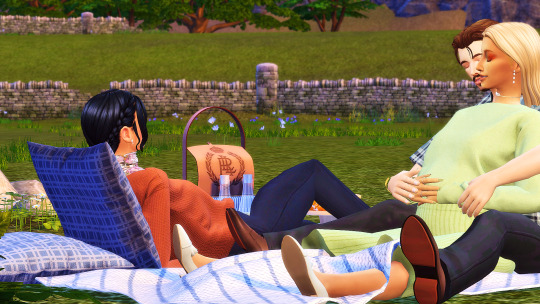
Here
I love this post a lot, it marks the beginning of a collab that will come out in the next arc. I thought it would have come out sooner, but I ride the waves of motivation. The picture itself was one of my favorites with that editing styles, and still is. February saw one of my favorite posts, featuring Jane and their kids (including Anne).
March
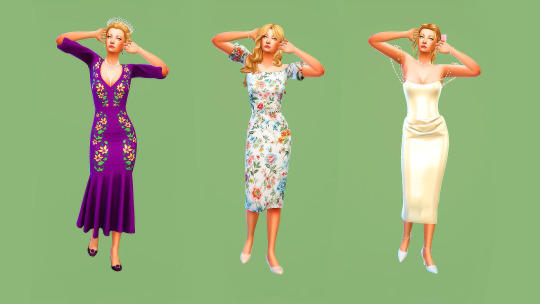
Here
And so begins my recent editing style. I love it so much. This post as well. And I was able to come out with the part two to this lookbook in this year, thats a win for me. The post itself really helped me establish more cultural things about the people of Esha and their connection to plants and colors. In March I made my first and probably only guide on Russian Titles and the first part of the "What Once Was, Will Never Be." The second part gets to come out wayyyy later.
April
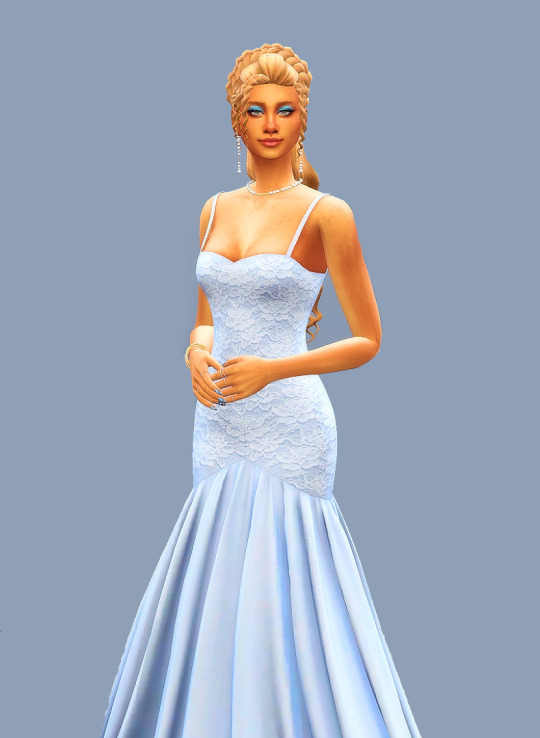
Here
My first poll! (I'm pretty sure). I just love dressing Esther up, and wanted a little cinderella moment, but Hildegard really did look way better in the dress (as well as the color chosen for her). This month I only posted 5 seperare posts, and most of it was asks.
May
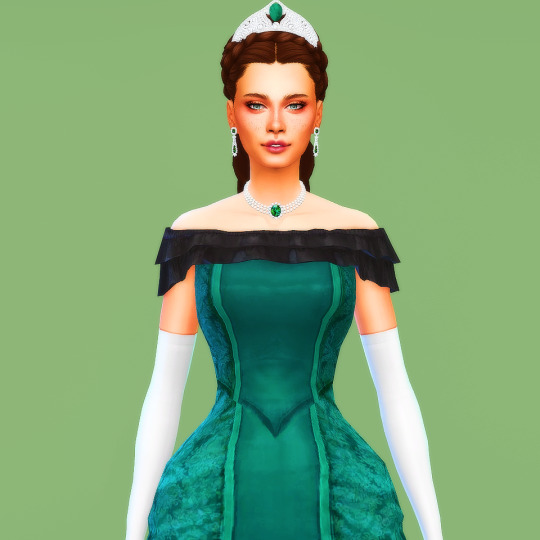
Here
An introduction of three Queens and a Grand Princess through out the history of Esha. (Including one for the future) I introduced a decent amount of future gens this month. I wish the mother's day post from this month got more traction than this. (It had my next two gens featured) I also did a couple of lookbooks.
June

Here
I finally had another story post this month and this post for some reason was the most popular of the month, and for the rest of the year until just recently. Its just a picture of a crown! I was so confused when I found out that it was my top post. Don't get me wrong I love the work and worldbuilding I put into the royal collection I made, but it just confuses me why it was so popular. I did a lot of worldbuilding in June.
July

Here
This was very fun to do! Also technically a worldbuilding thing for me in the fashion, but the portraits that came out of it are really pretty! I didn't have much going on for this blog during July.
August

Here
A lookbook of Arabella's outfits! This was very fun, it got me more interested into what They wear for royal outings and just in general. This month saw another story post (One of my favorites) and the start of the Six Queens storyline!
September
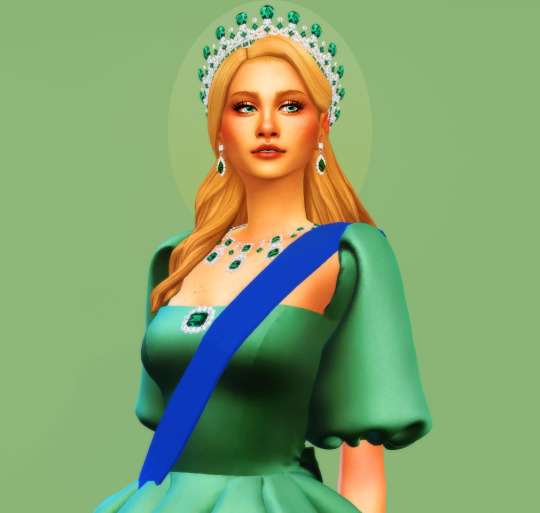
Here
This is an Au post where if Anne didn't marry George, Esther would have, for ...reasons :) The month saw the beginning of chapter two of the six queens story and just some of my favorite edits as well. Like some magazines I did for Esha.
October
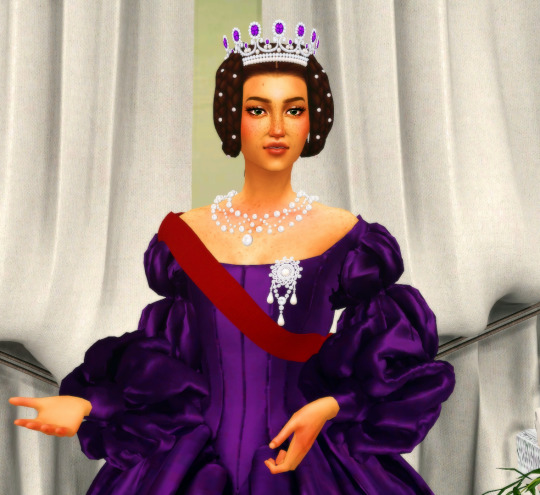
Here
This was the beginning of a series of portraits I did for the modern royals of Catalia. October was also the start of Sima and I creating a second short story other than Six Queens, which will come out after Six Queens has finished. It also saw two of my favorite posts of the Six Queens short story and the end of Six Queens Chapter Two.
Novemeber

Here
One of my favorite posts of all time, and getting to feature some of my favorite historical sims that are now dead in the present. The month itself was mostly just portraits and answering asks.
Decemember
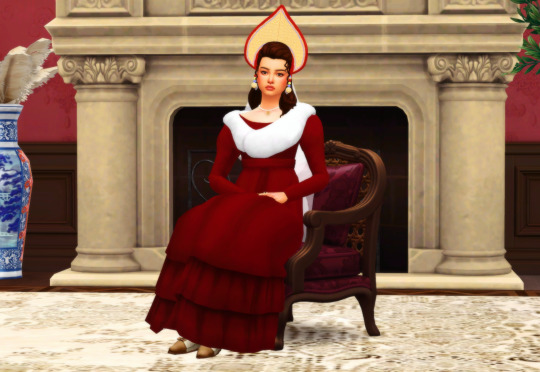
Here
The post that beat the crown! I was so happy with how this came out. This involed more worldbuilding for the country of Chelyabinsk, and me wishing for more Kokoshnik cc. This portrait was used for Tsarina Sofiya's wikipedia post, which I accidently forgot to add her death date, which I will add at a later date and publish again with other wikipedia articles. I want to add more just to hers. The rest of this month was more portraits and a chanukkah post that I planned on having more to it, which I do plan on posting for when its chanukkah in universe (insert crying emoji here) and I got to 200 followers, which was very exciting!
I can't wait to see what happens in the next year for this blog. I have a lot going on in TBS and I can't wait to publish it all. Happy New Years!
22 notes
·
View notes
Text
Thoughts On . . . Sherlock Holmes: The Awakened Remake
Frogwares’ remake of Sherlock Holmes: The Awakened is one of the most unsung game releases of 2023. So let’s take a quick look at the new features of the title and how they compare with the original.
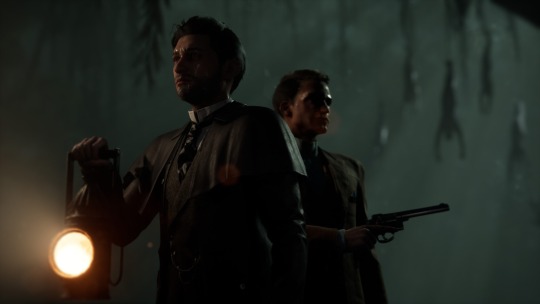
If you’re unaware, Frogwares is a studio based in Ukraine, a country currently repelling a Russian invasion. The devs have repeatedly addressed their struggles and yet they launched it anyway. For that reason, I feel it would be inappropriate to score The Awakened. I make an effort in all my reviews to respect the developers who’ve put in the work to make the game I’m playing, even if I’m not a fan of the game itself. But making a game during an actual and presently-occurring war is another matter entirely.
That being said, I think The Awakened Remake merits examination, even if I don’t want to review it. If nothing else, the game is a fascinating glimpse into the evolving story of point-and-click adventure games and their place in the greater gaming landscape. It’s also instructive to compare the two different Holmeses, to see how the character changes with several years of pop culture reshaping.
Second Awakening
The Awakened Remake feels like the culmination of Frogwares’ attempts to evolve its signature adventure game series from a post-Syberia form to a post-Telltale form. In the Dark Ages (a.k.a. the early aughts), adventure games adhered almost religiously to the Grim Fandango style: Third-person clicking navigation with viewpoints fixed in what I call “security camera” position. The Awakened (the original, that is), began the transition away from that to first-person exploration -- the Myst style, if you will.
The series continued to experiment with different stories and gameplay types. It vacillated between first- and third-person, tested new detection mechanics, and even dipped into true crime with the audacious Jack the Ripper recreation. The series rebooted with The Devil’s Daughter (though it retained at least a few story details unique to the previous game series). I’m not sure whether Chapter One and The Awakened Remake are set in the same continuity, though the retention of the new voice cast would suggest so.
Now here we are in 2023, and what does a Sherlock Holmes adventure game look like? It’s a third-person exploration title with an over-the-shoulder camera and the environments are a series of contained maps. In other words, it looks like several of Telltale’s later titles, or Dontnod’s. That’s not a bad thing . . . it’s just an observation of how the medium has evolved and Frogwares’ Holmes along with it.
The Awakened remake is also a microcosm of Sherlock Holmes’ . . . let us say “changeable” position in pop culture. The Holmes of the original Awakened was more of a Jeremy Brett-style depiction, hewing close to the source material’s dry wit and intense focus. The Holmes of the remake, on the other hand is -- being blunt -- young, hot, and mentally unwell. It’s not really to my taste, I’m not gonna lie. It’s clear the impetus for this comes from BBC Sherlock, which I despise. But the remake Holmes has an earnest gumption I’ve never seen in the character before -- it’s a choice, and not one I dislike.
Lovecraft’s Walking Tour
One of the benefits of remaking Awakened is that Frogwares has a chance to elevate a game that, through a combination of underpowered graphics and muddy art design, never had a chance to serve Lovecraftian horror as it’s meant to be served. And for the most part, they did -- there’s a creeping sense of wrongness on the periphery of most scenes, at least when you play as Holmes, a feeling that something isn’t quite right.
That’s the essence of Lovecraftian horror, in my opinion, this sense that something’s wrong, but there’s no way for your tiny human brain to understand what. One of the reasons I enjoy both iterations of this game is because Sherlock Holmes is the type of person who would absolutely refuse to accept there’s something his brain can’t comprehend. That makes him uniquely vulnerable to being overwhelmed by that sensation. Watson’s POV is more grounded and reliable by comparison.
The locations are mostly similar to what they were in the original, though the asylum section is much shorter and cuts out a subplot foreshadowing the arrival of one Moriarty. New Orleans serves a nice slice of Southern Gothic horror to balance out the traditional European Gothic elsewhere in the game. It’s a bit of a shame that Frogware’s didn’t correct one particular oversight: For a game based on Lovecraft’s work, we never go to New England, Lovecraft Country itself.
As far as gameplay goes, I only have one major complaint: This game desperately needs an auto-run option. Or at the very least, the sprint button needs to be sticky -- meaning, you press it once and the characters run until you press it again. Having to hold down a button to get them to get a jog on feels archaic, especially since the environments are much bigger than in your average adventure game.
Our next case, Watson?
Point-and-click adventure games will never be to everyone’s taste, no matter how much a developer might wish to court a bigger audience. Aiming for the Walking Dead/Life is Strange is a wise choice of direction for the Frogwares’ series if it’s going to capture any mainstream appeal while retaining its identity. That is to say: This is a good remake and I like where Frogwares is going with its new series.
Assuming the new series will follow the old, we’re looking at a remake of Sherlock Holmes vs Arsene Lupin next. Sherlock Holmes, tormented lad that he is in the new series, definitely deserves a lighthearted chase with a gentleman thief, so I’m looking forward to what Frogwares does next. My best wishes to them!
#sherlock holmes the awakened#midweek madness#sherlock holmes#frogwares#frogwares sherlock#frogwares watson
33 notes
·
View notes